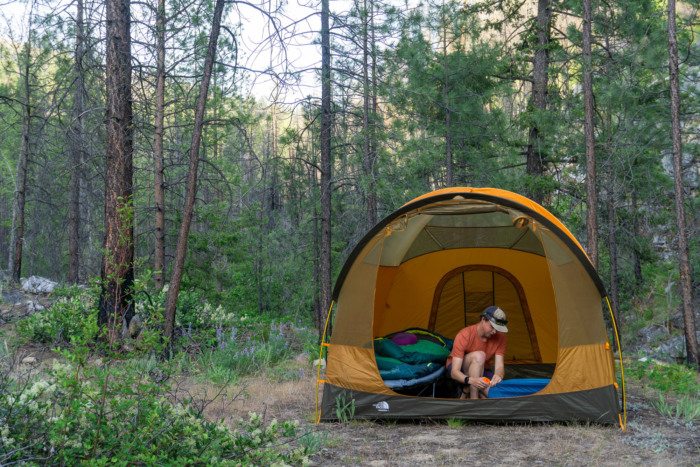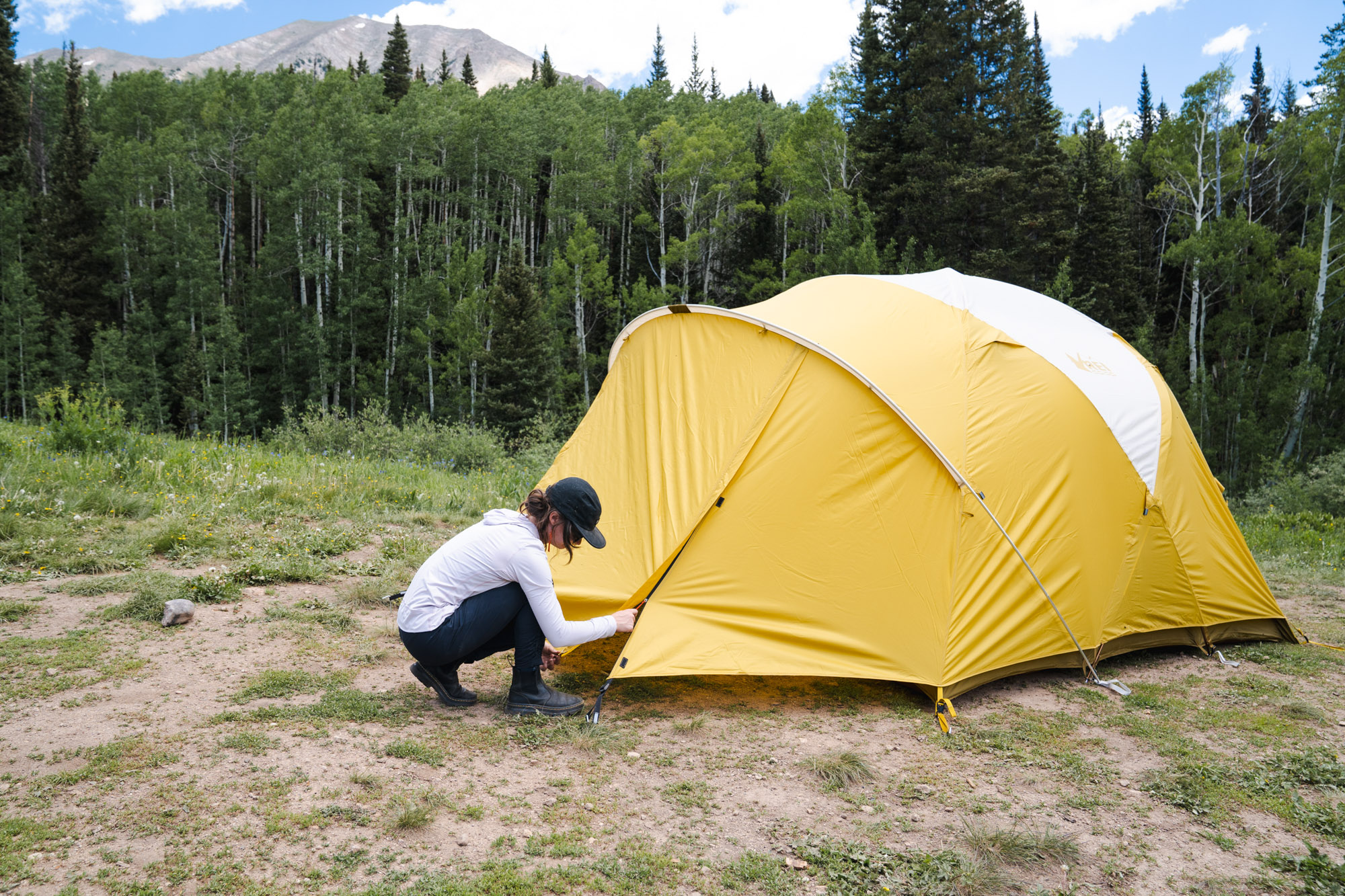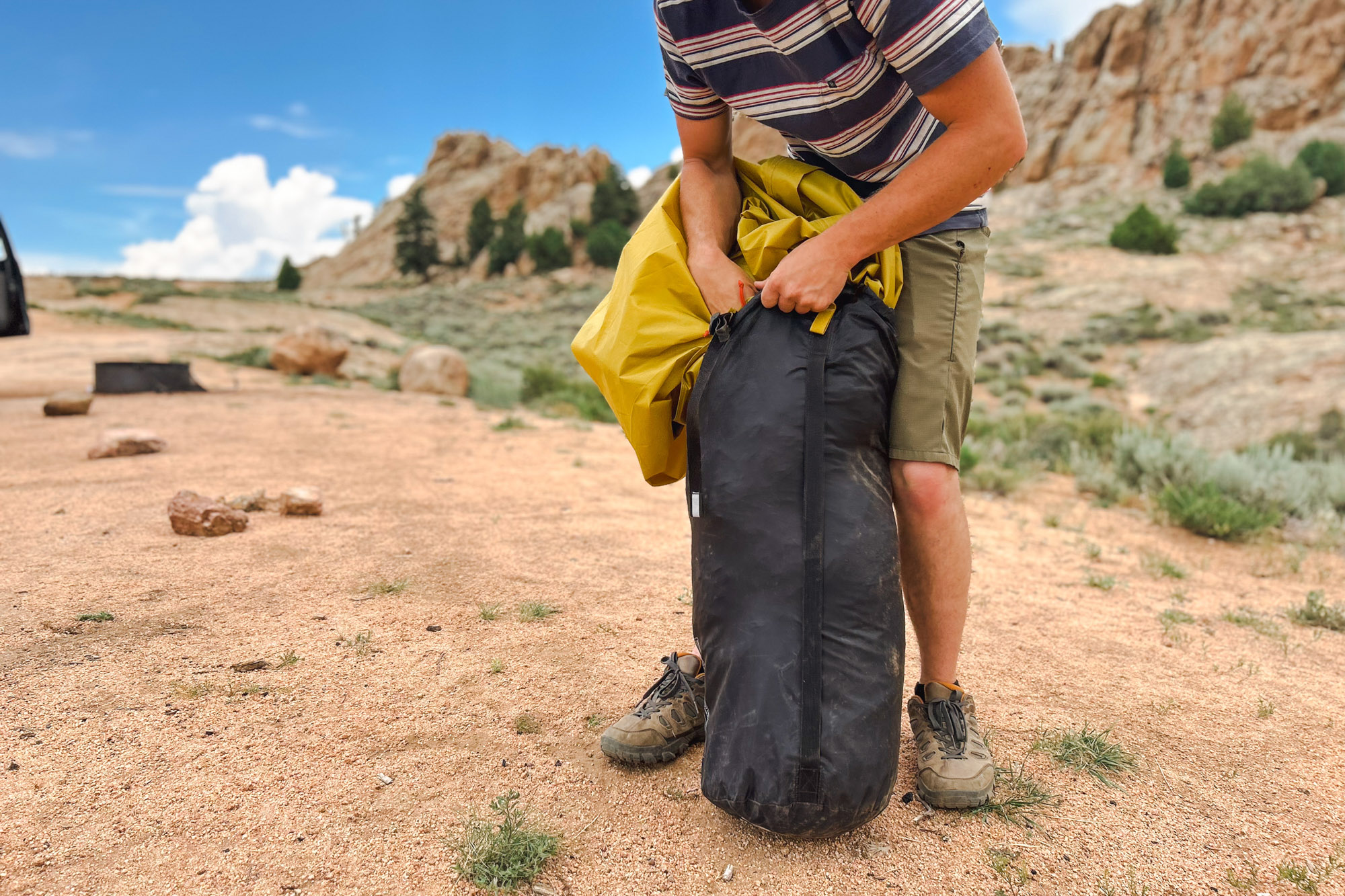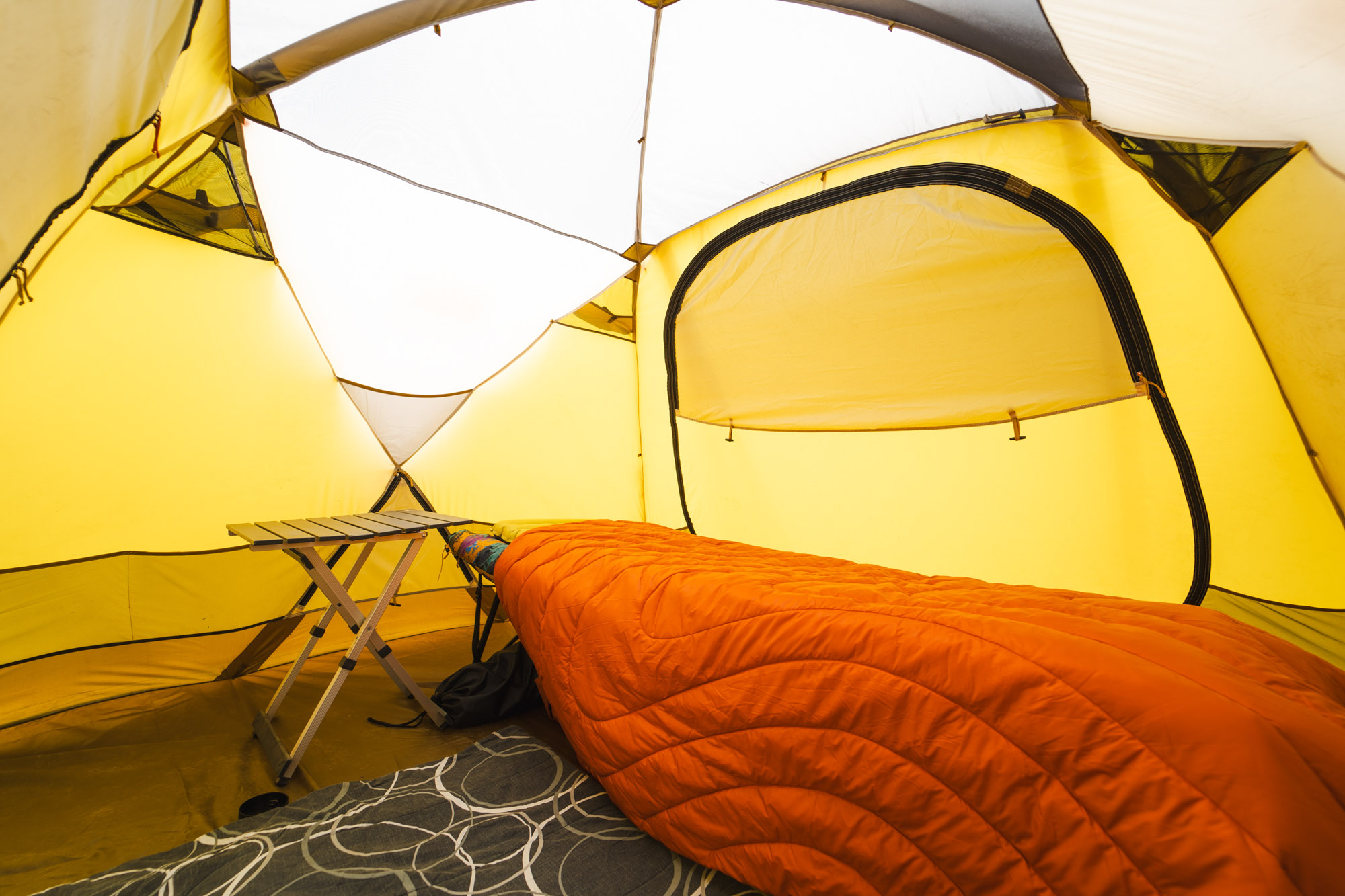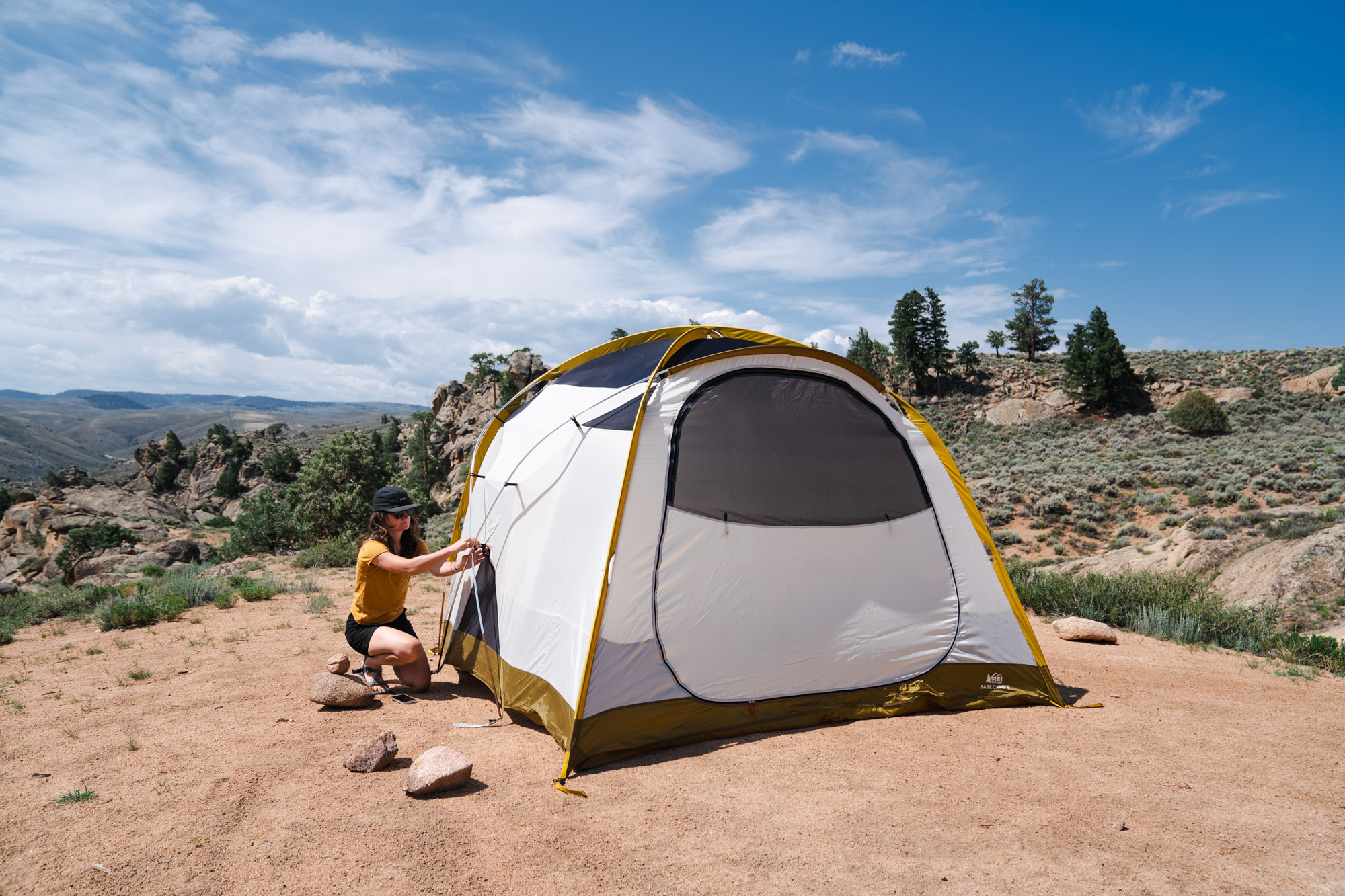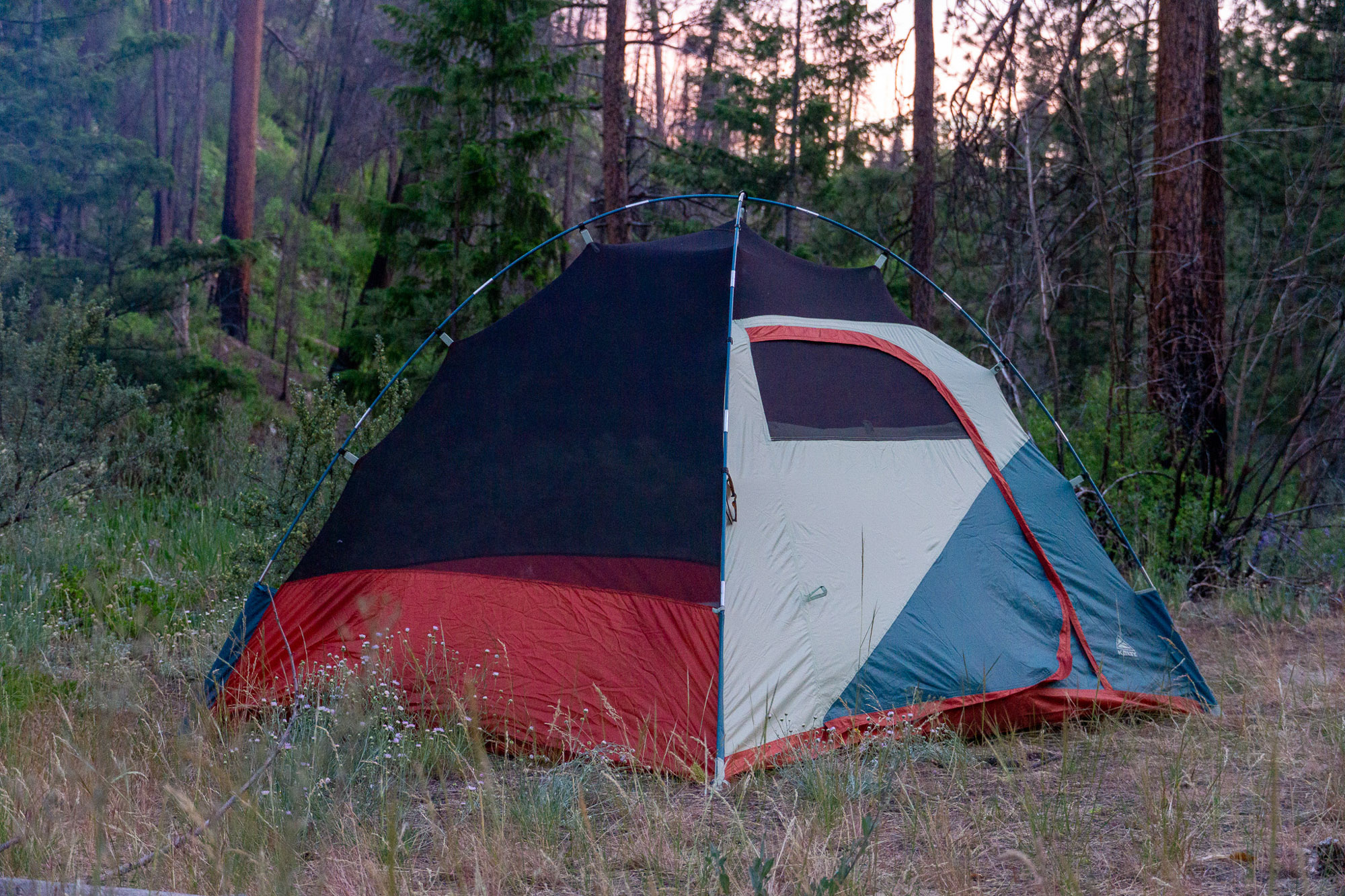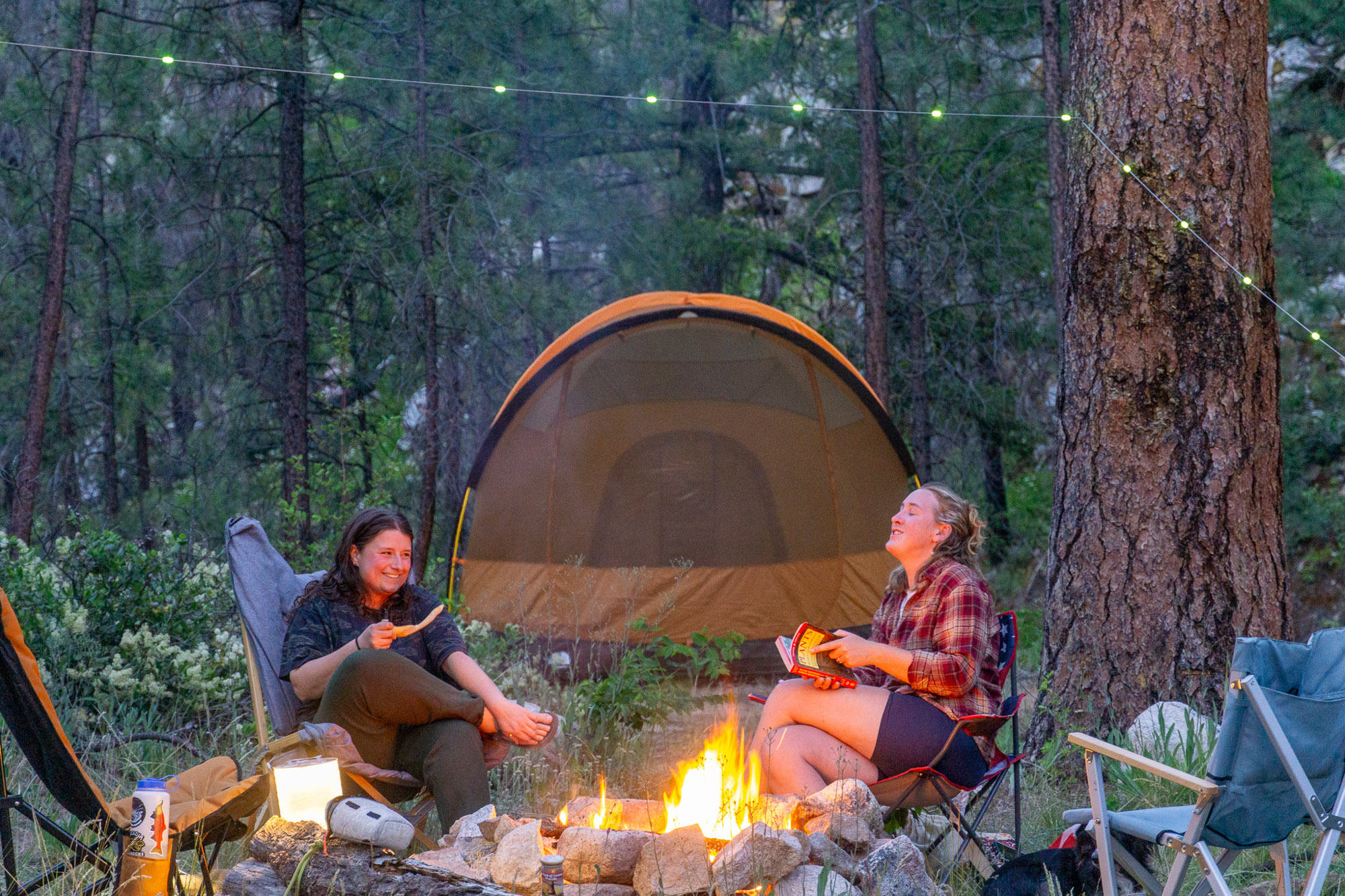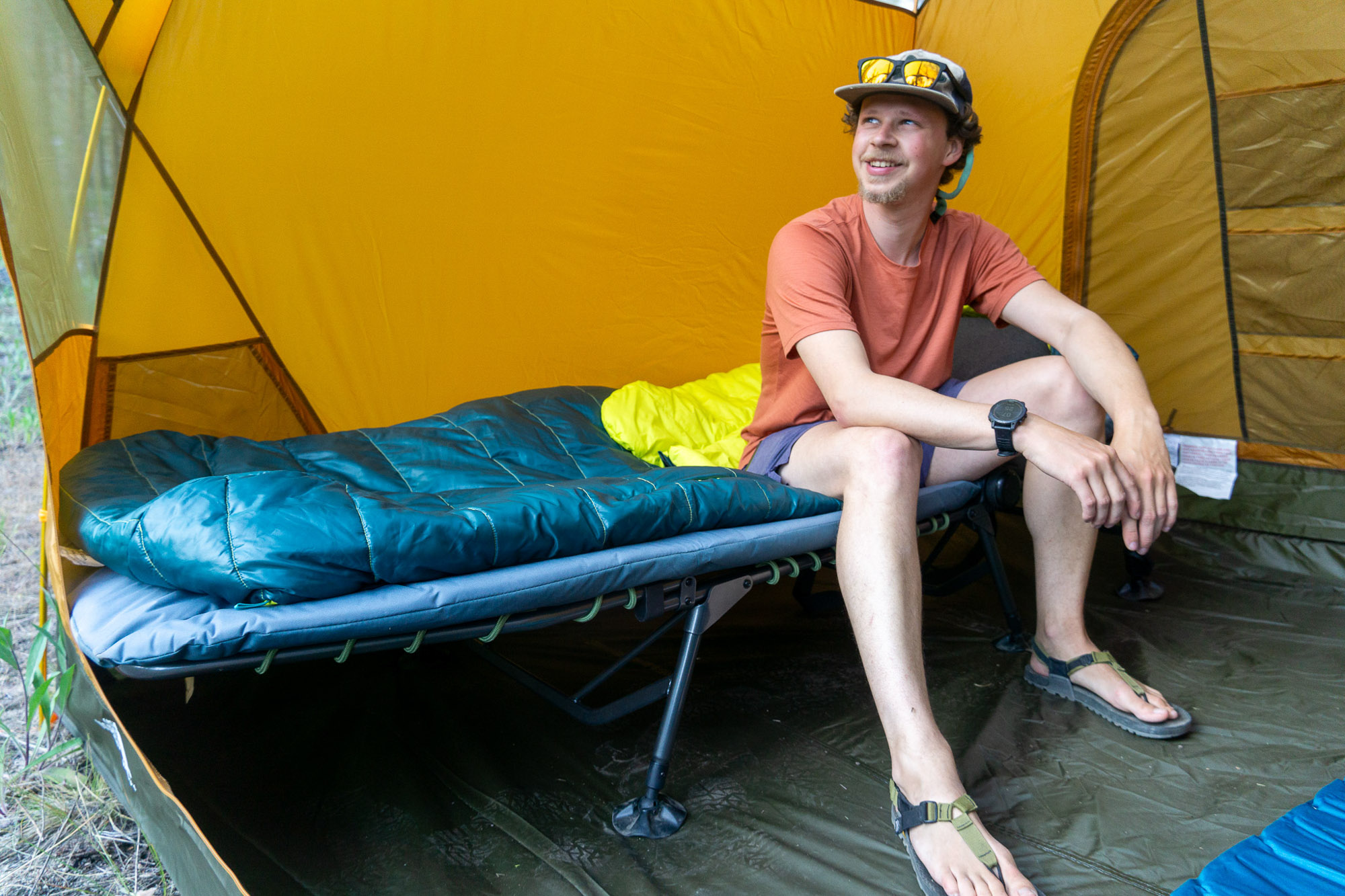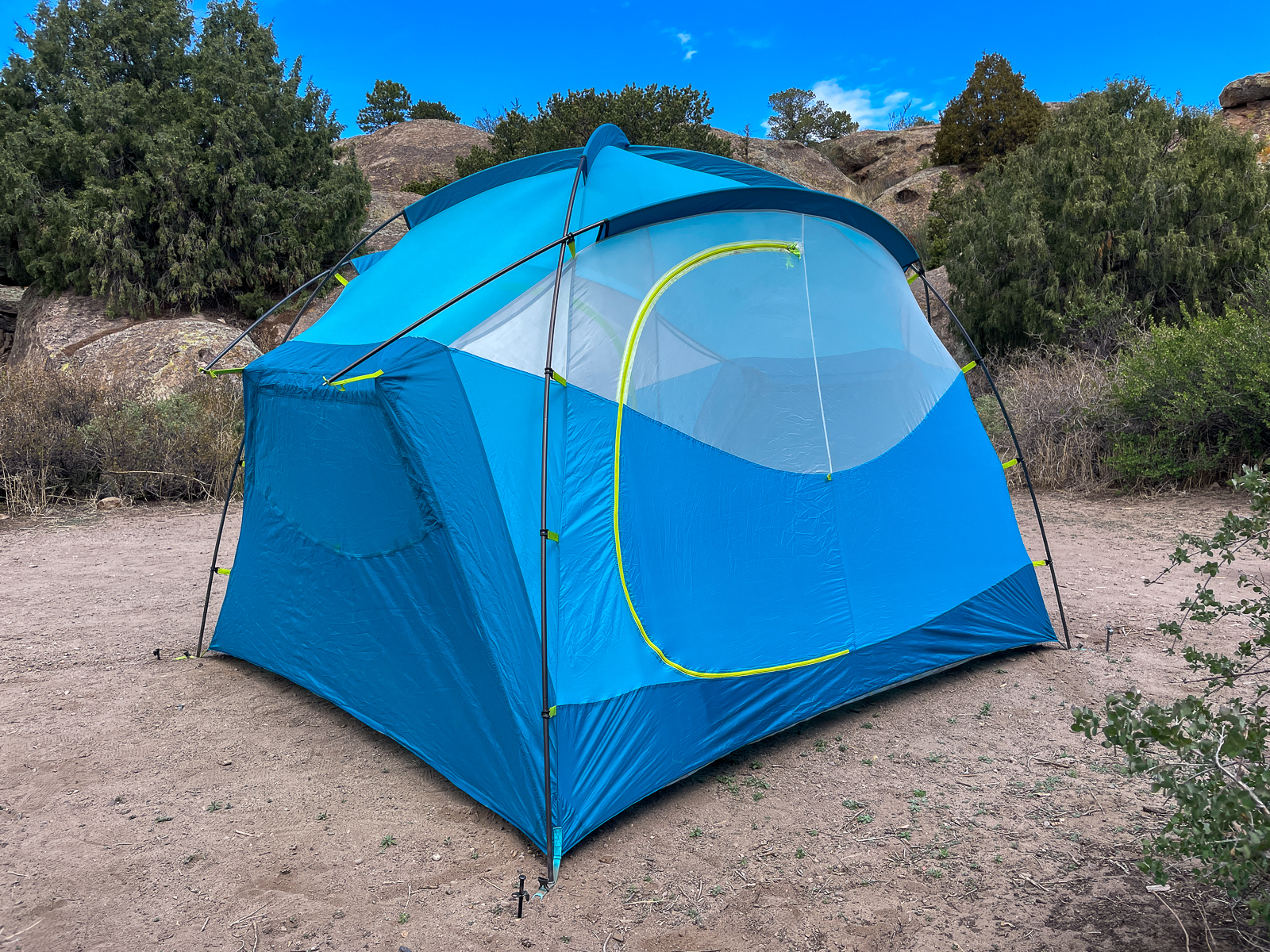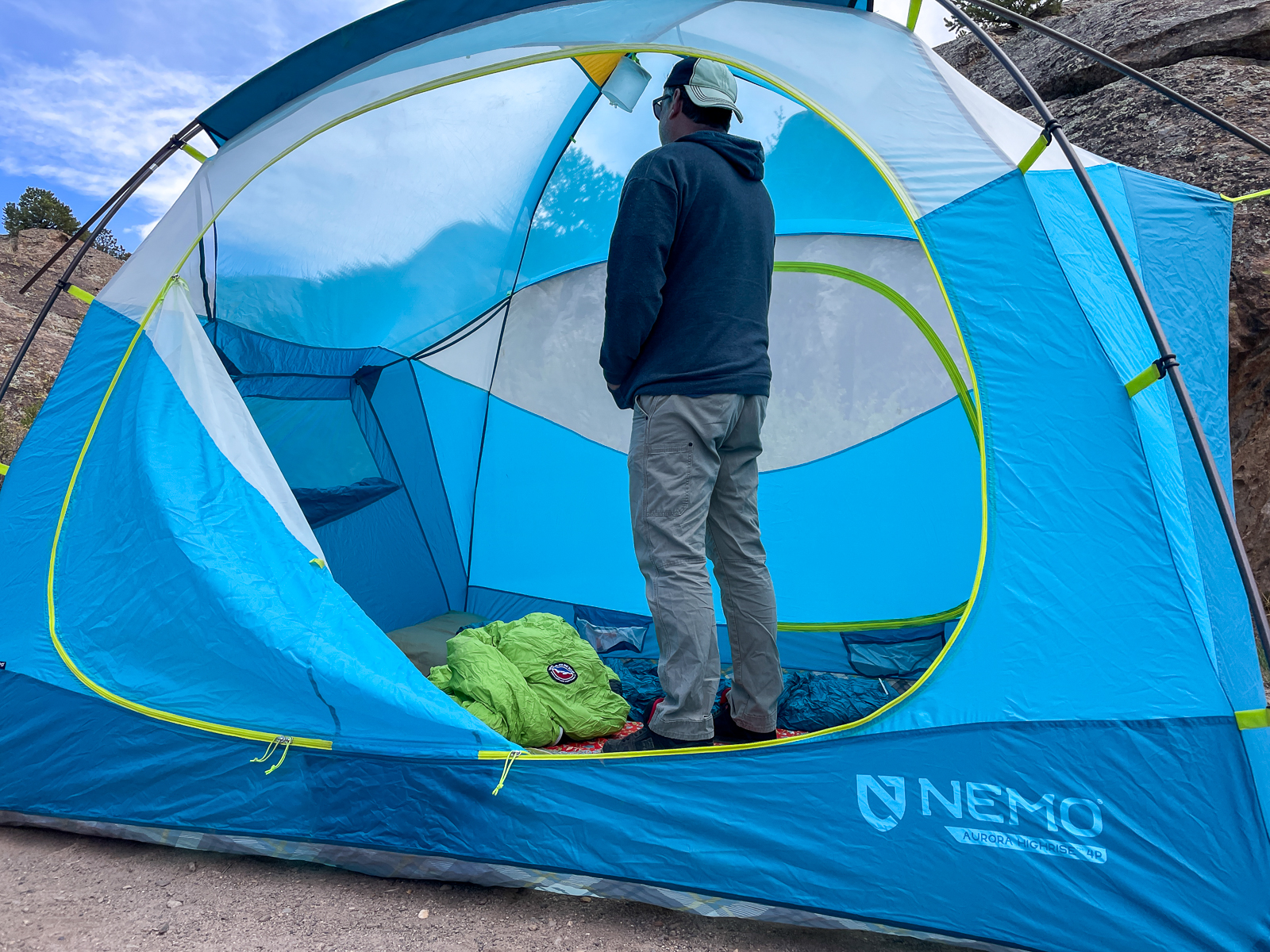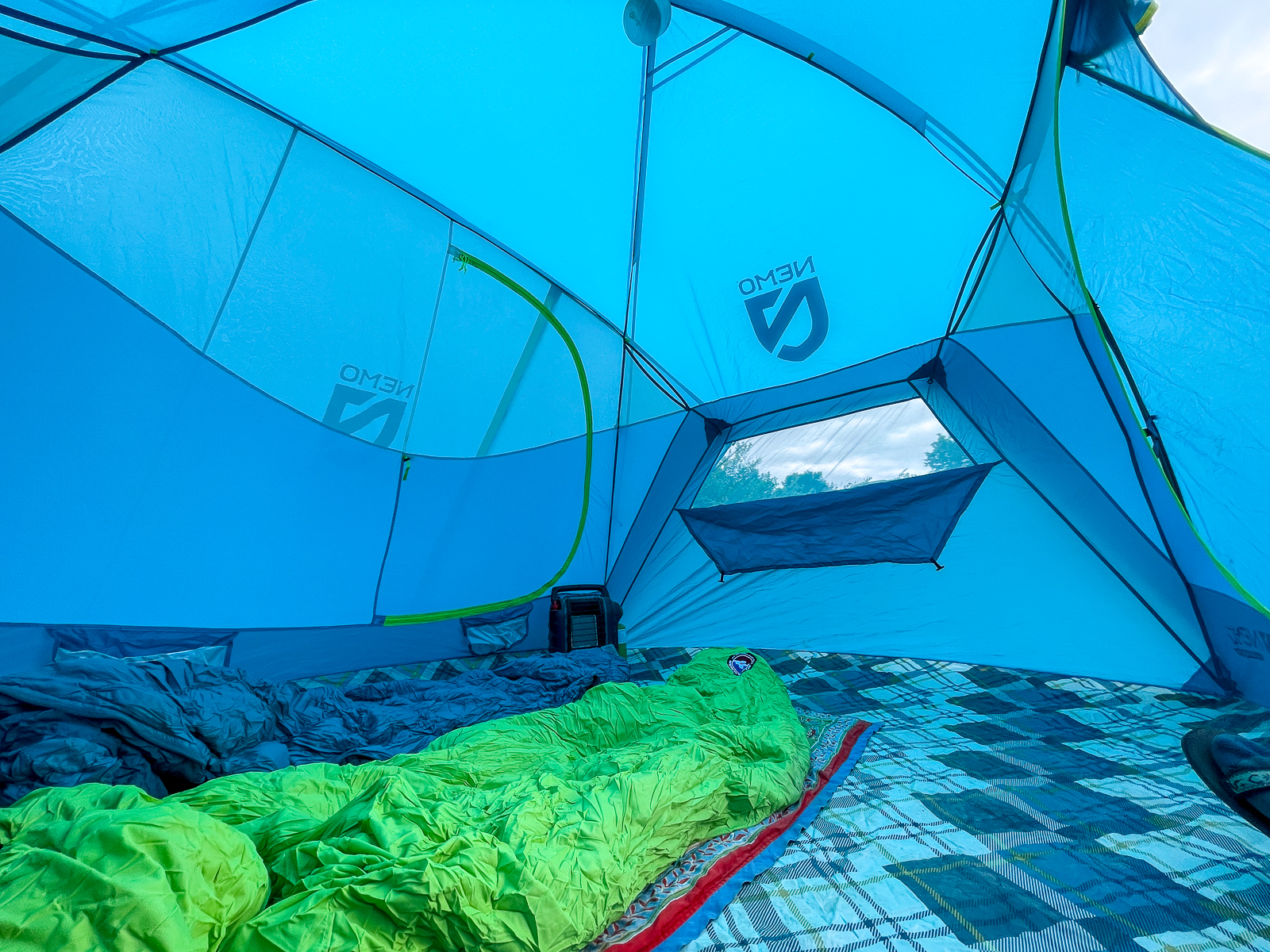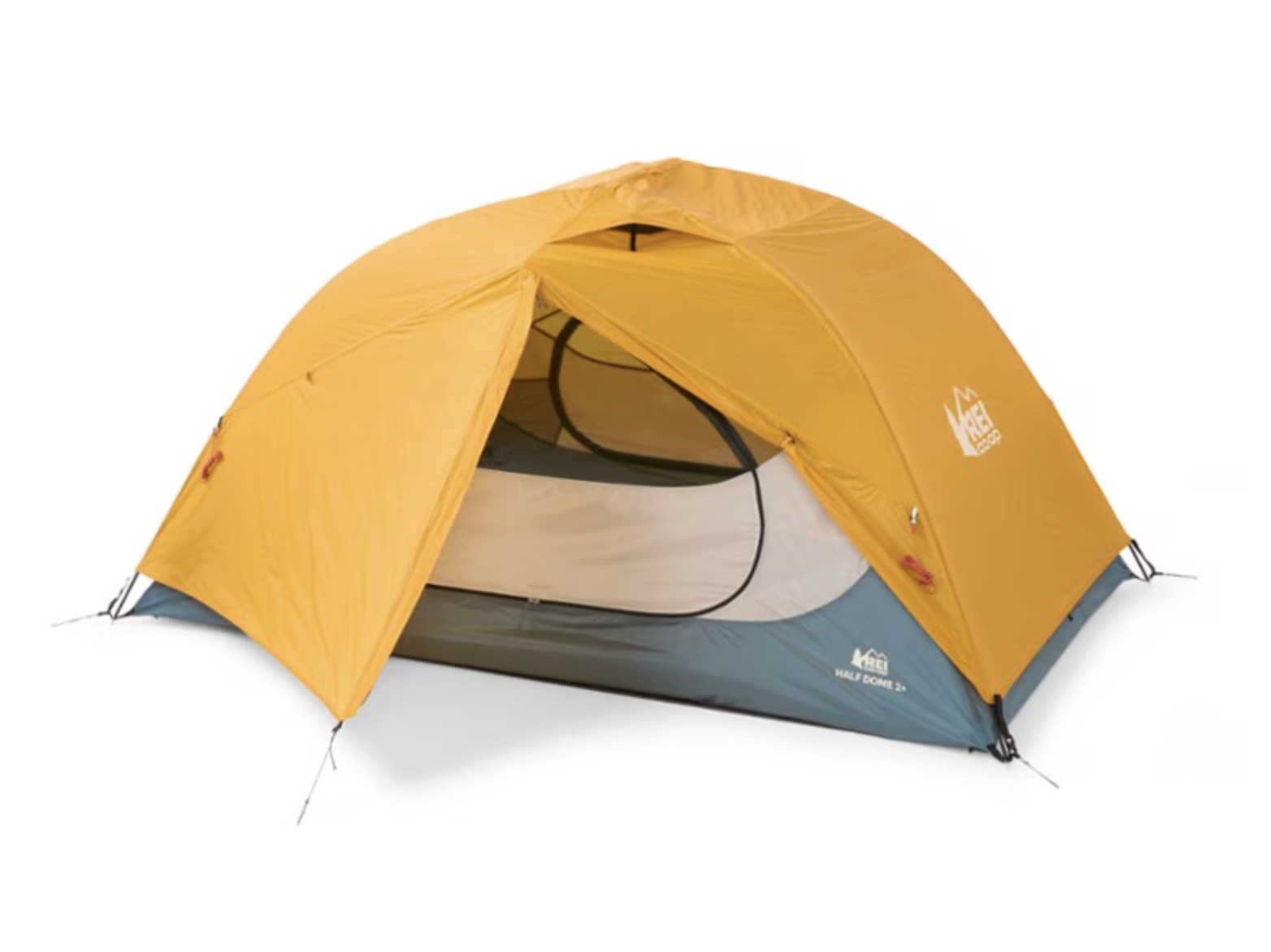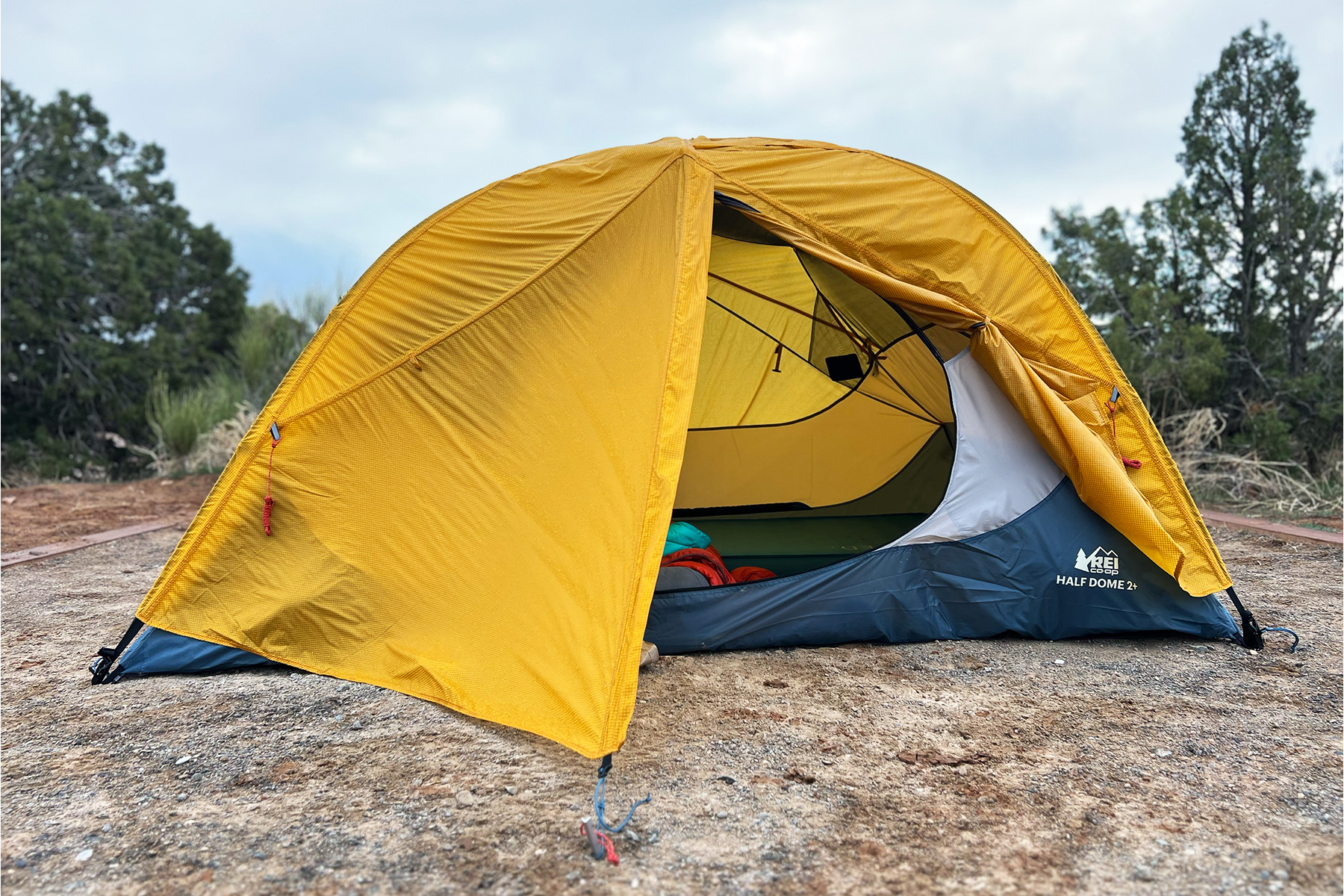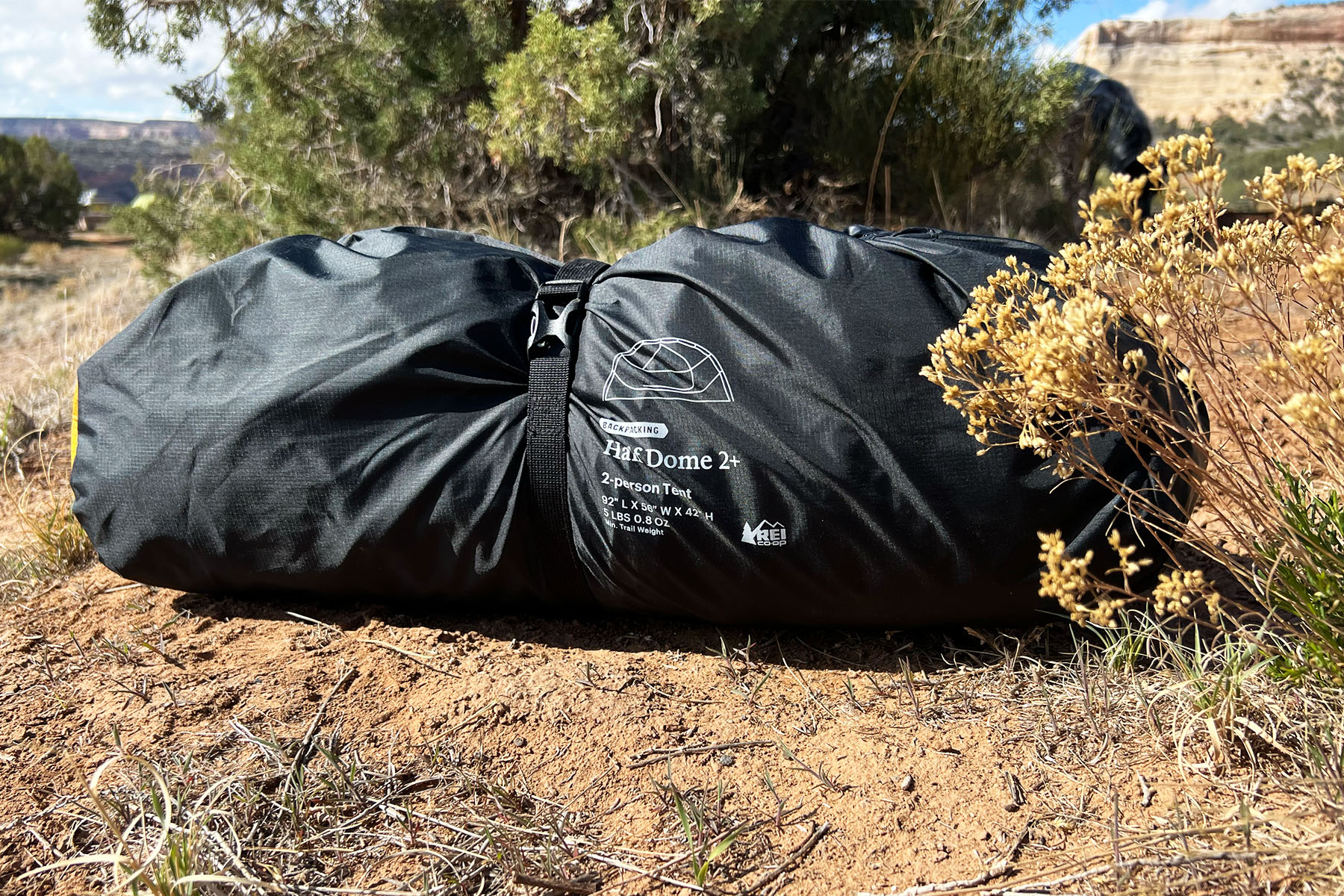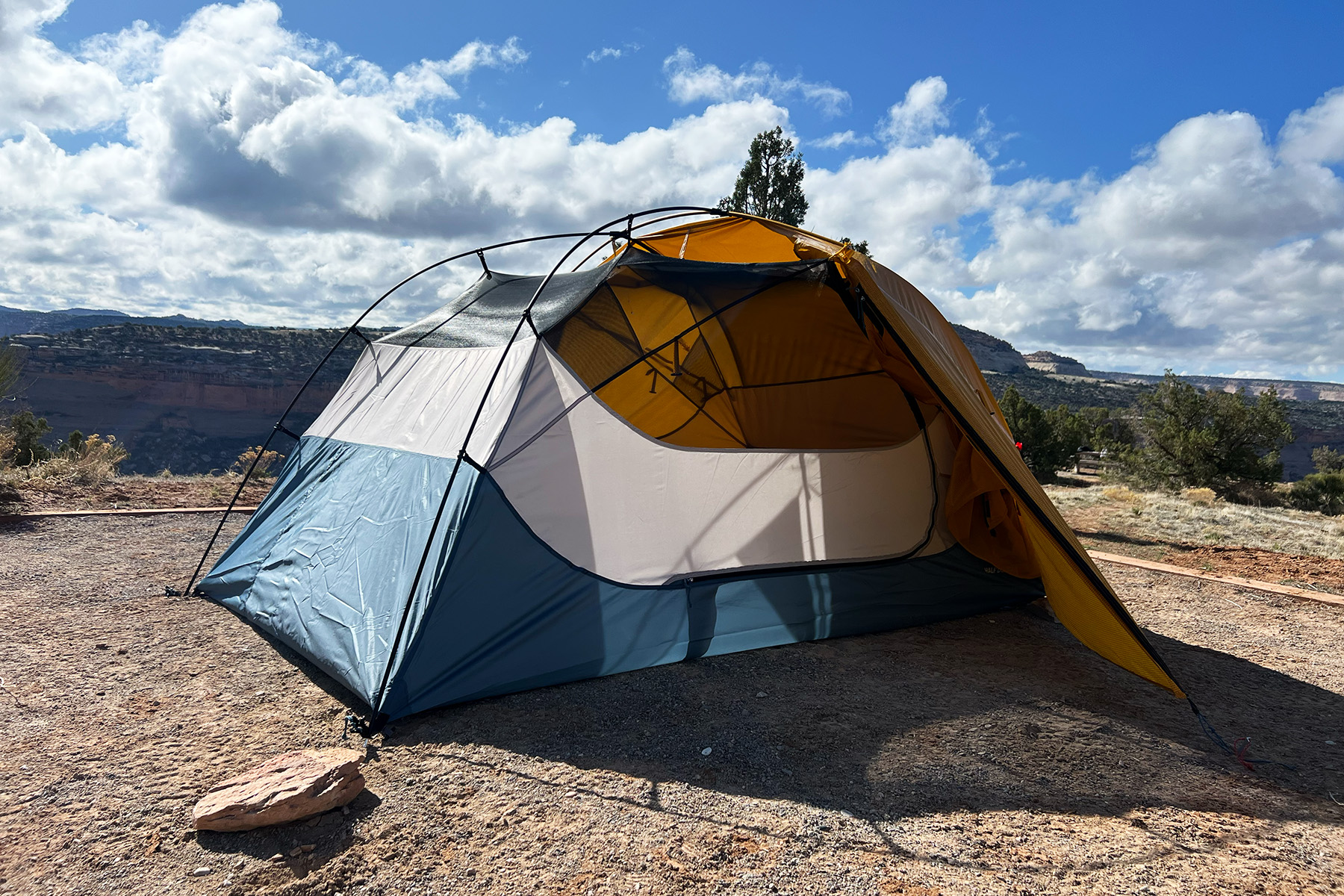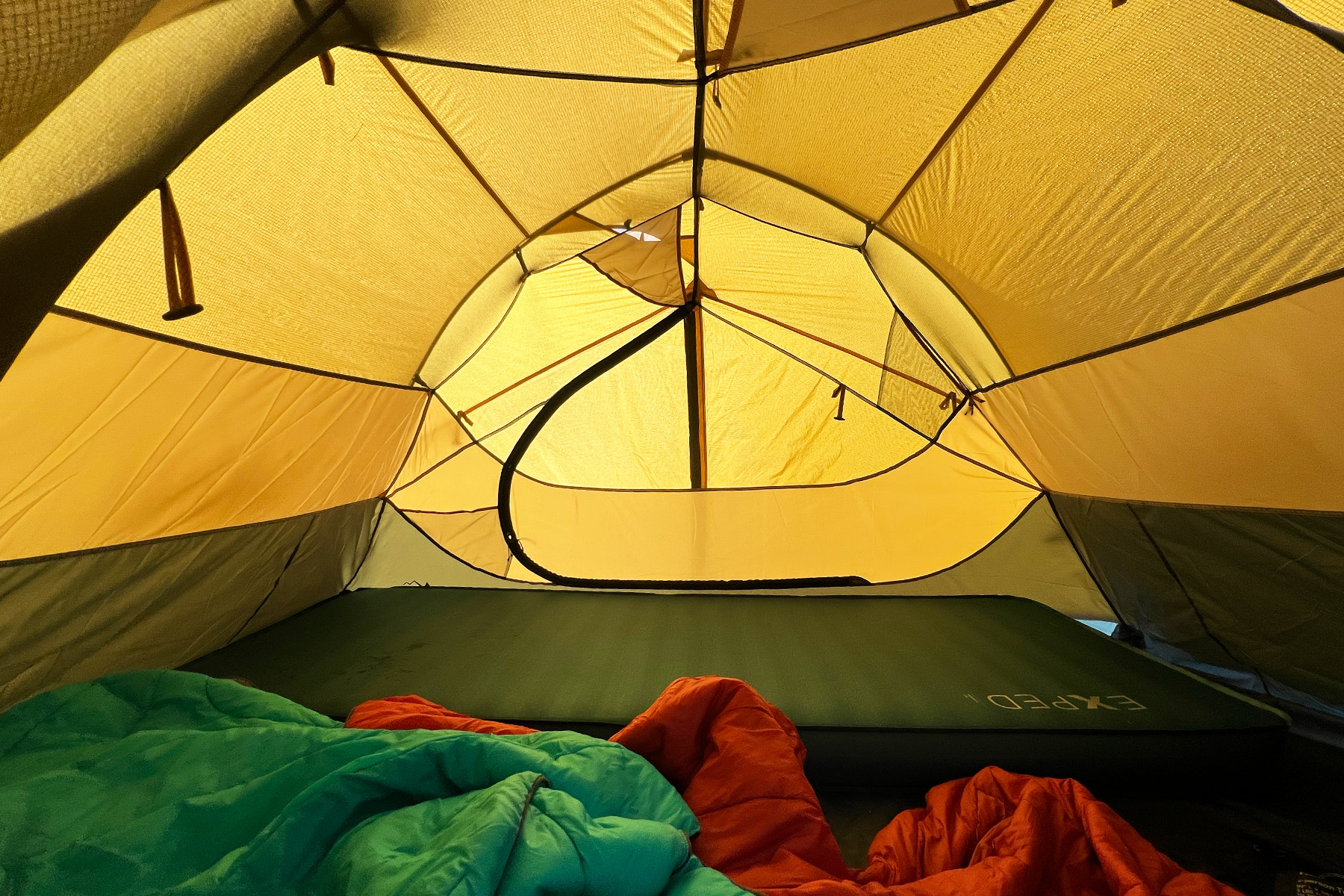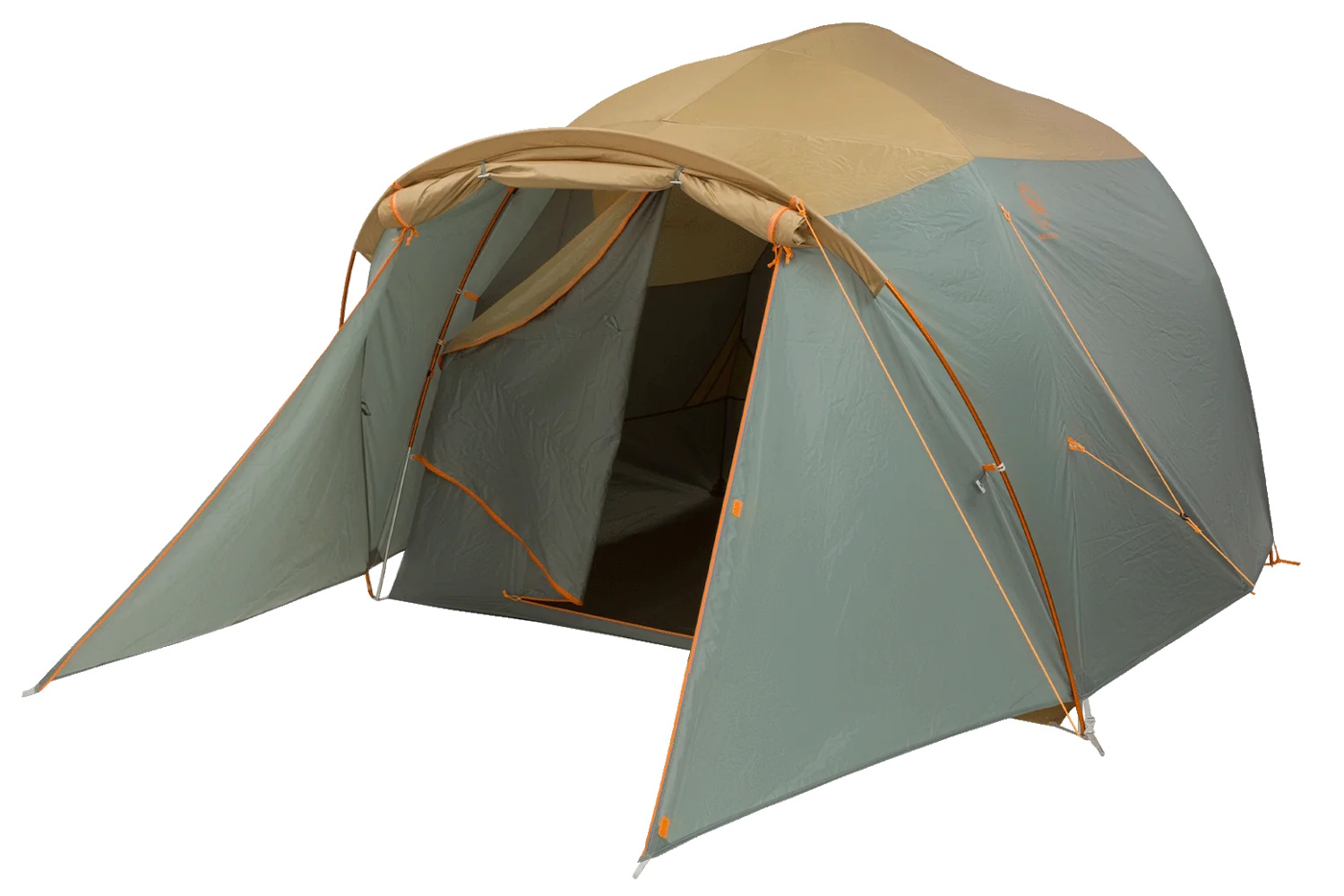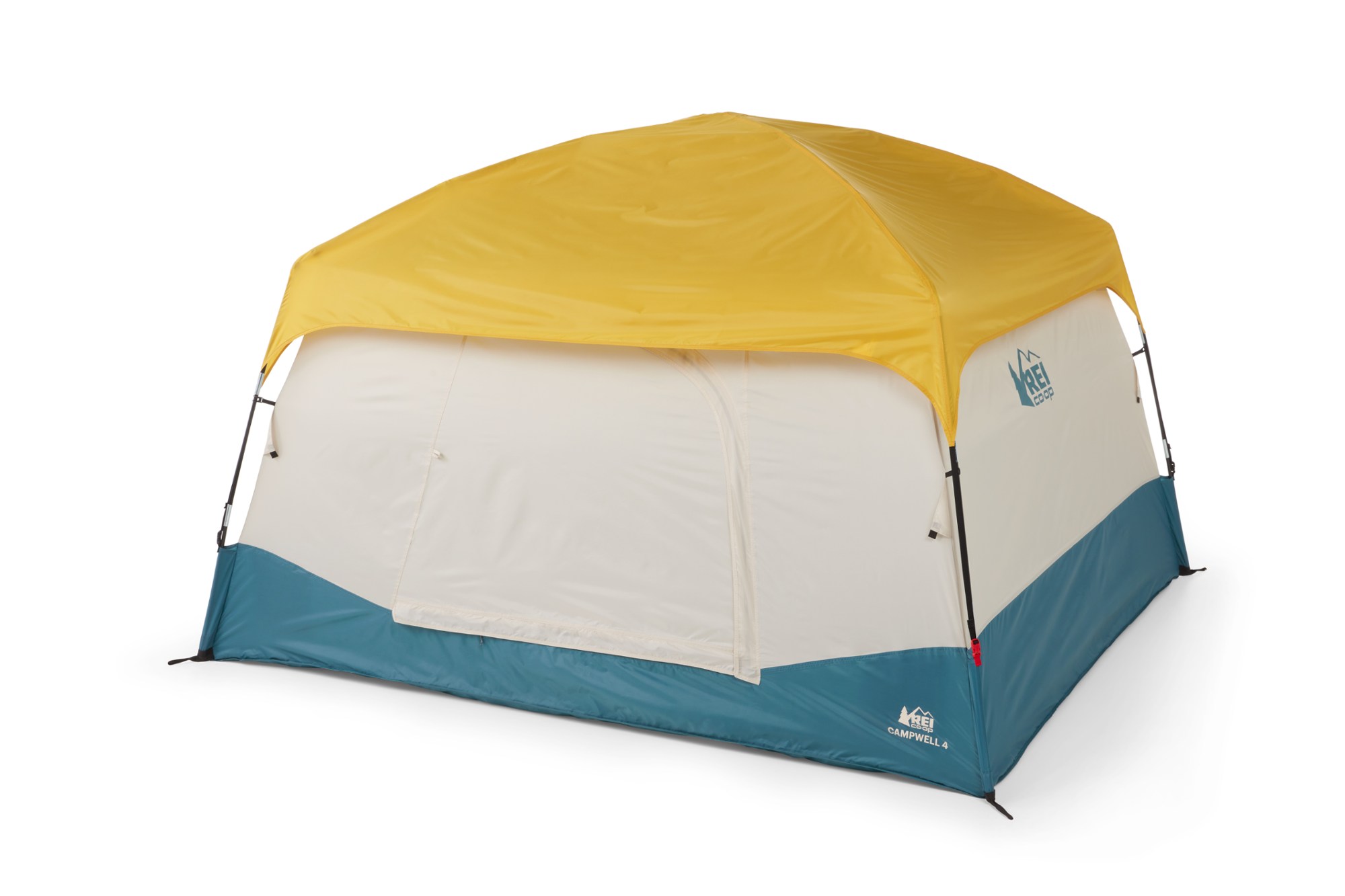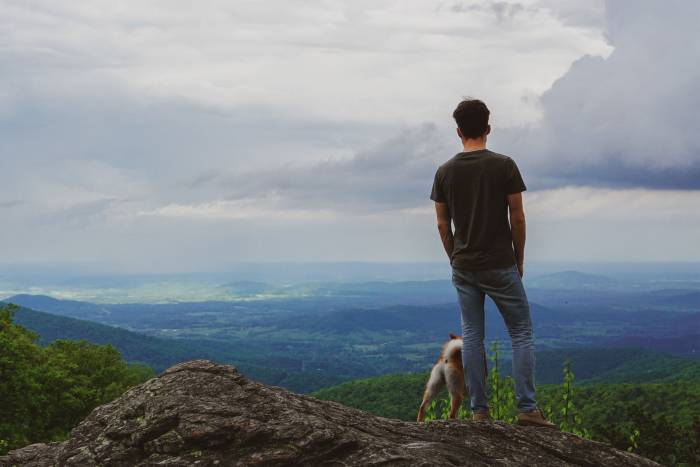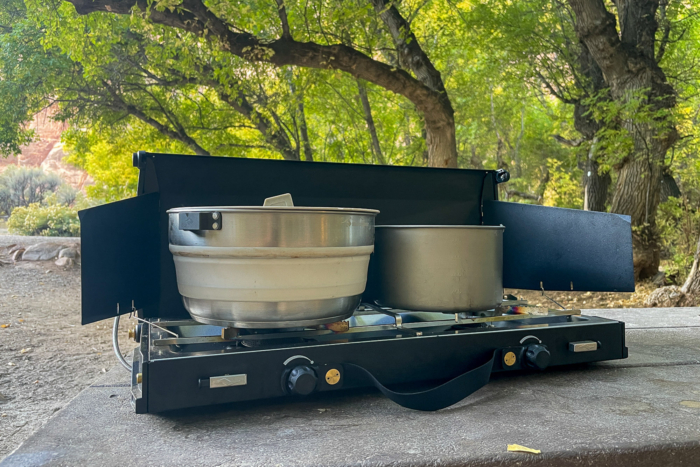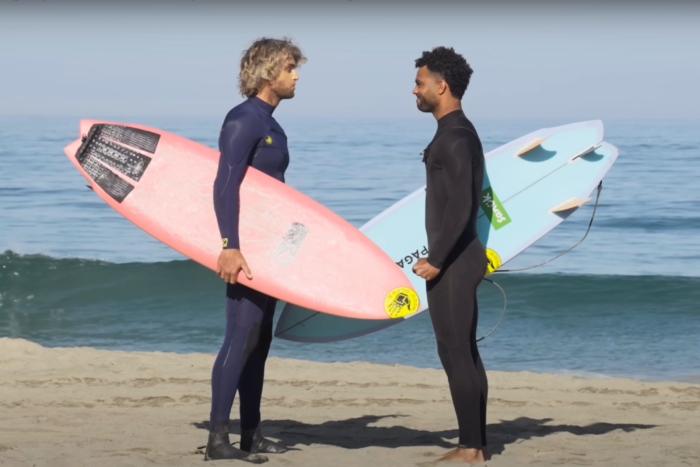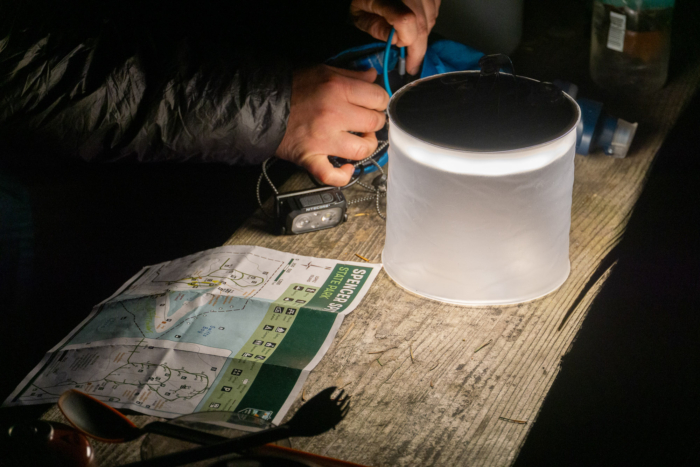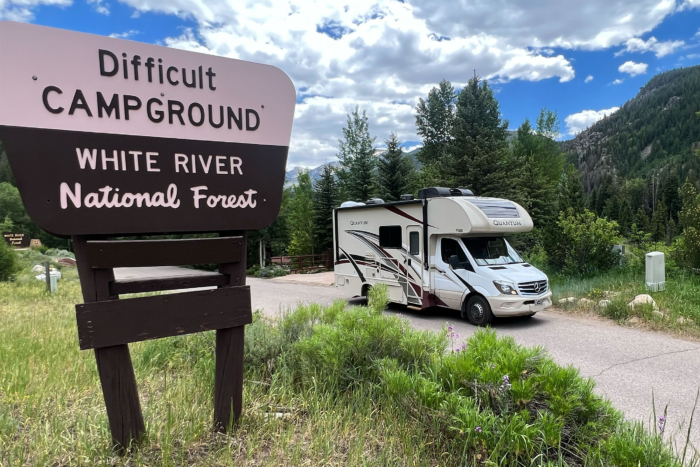If you’re going to camp outside, chances are you’ll need a good mobile roof over your head — unless you’re one of those cowboy-camping thru hiker types. We’ve logged some shut-eye in hundreds of shelters, intensely used more than 40, and winnowed down our gear rooms to the 12 best of the best camping tents out there today.
Our team of experts brings decades of camping experience in every sort of condition imaginable, from national park campgrounds to multiday festivals to long road trips. We weighed them on everything from ease of set-up and headroom to how fun and funky the color schemes are.
Some tents are wilder-nests that thrive in a more backcountry-adjacent use, like the Kelty Discovery Basecamp, while others, like our top pick, the REI Co-op Base Camp 6, are downright frontcountry palatial. We’ve also found having a real gear garage like the The North Face Wawona 4 in the stable to be important on equipment-heavy trips, and a front-to-backcountry tent like the REI Co-op Half Dome 2 Plus to work for a range of different adventures.
Consider these award winners our top seven for pretty much any camper, followed by a series of solid shelters for more specific camping weekends.
Editor’s Note: We updated our Camping Tent guide on June 17, 2025, to revise much of our buying advice and add additional context. We also elevated the North Face Wawona 4 to the award-winning status of ‘Best in Vestibule Storage Space’.
The Best Camping Tents of 2025
- Floor area: 84 sq. ft. (110" x 110")
- Weight: 20 lbs., 11.5 oz.
- Height: 74"
- Footprint included: No
- Number of doors: Two
- Carry size: 24" x 11" x 11"
- Seasons: 3-4 season
- Best for: All-weather camping where comfort is in high demand
Pros
- Huge vestibule
- Excellent weather resistance
- Easy to set up
- Compatible with other REI tent accessories such as canopies
Cons
- Heavy at 20 pounds
- Expensive
- Floor Area: 53 sq. ft. (97" x 79")
- Weight: 8 lbs., 8 oz.
- Height: 58"
- Footprint Included: No
- Number of Doors: One
- Carry Size: 23" x 6"
- Seasons: 3-season
- Best For: Casual weekends of car camping, festivals, beach camping
Pros
- Easy and intuitive to set up
- Inexpensive
- Pre-attached guylines
- Storage duffel is easy to stuff and unpack
Cons
- Rainfly isn't full protection
- Fiberglass poles
- Floor Area: 70.5 sq. ft. (100" x 100")
- Weight: 35 lbs., 1 oz.
- Height: 75"
- Footprint Included: No
- Number of Doors: Four
- Carry Size: 27.4" x 14" x 12.8"
- Seasons: 3-season
- Best For: Mondo-sized camping trips with the whole crew
Pros
- Huge tent for four people
- Doubles as a massive shelter for cooking, entertaining, or eating
- Extremely durable
- The sleeping area is very large and protective from the elements
Cons
- Expensive
- Too big for smaller campsites
- Floor Area: 58 sq. ft. (96" x 90")
- Weight: 13 lbs.
- Height: 68"
- Footprint Included: No
- Number of Doors: Two
- Carry Size: 27" x 10" x 10"
- Seasons: 3-season
- Best For: Camping with extra kit to store in the vestibules, or just kicking back beneath the shade
Pros
- Unique second door design
- Plenty of interior storage pocket options
- High interior ceiling
- Relatively lightweight for the space
Cons
- Rainfly isn’t the most intuitive to put on
- Rear door isn’t covered by rainfly
- Floor Area: 62.5 sq. ft. (100" x 90")
- Weight: 15 lbs., 14 oz.
- Height: 75"
- Footprint Included: No
- Number of Doors: Two
- Carry Size: 25" x 8.5" x 8.5"
- Seasons: 3-season
- Best For: Camping with the whole family, sleeping on cots, and tall parents
Pros
- Steep side walls bumps up livable space
- Fun print on interior floor
- Both doors stow away completely
Cons
- Rainfly doesn't provide 100% coverage
- A little heavier than comparable tents
- Floor Area: 35.8 sq. ft.
- Weight: 6 lbs., 3.6 oz.
- Height: 42"
- Footprint Included: Yes
- Number of Doors: 2 doors
- Carry Size: 22.2" x 7.5" x 7.5"
- Seasons: 3 season
- Best For: Everything from frontcountry camping to shorter backpacking trips
Pros
- Extremely spacious with lots of headroom for two
- Very straight-forward, user-friendly setup/breakdown
- Well-thought-out interior with numerous pockets
- Footprint is included
Cons
- Somewhat heavy/large for solo backpacking
Other Camping Tents to Bed Down In
There are plenty of camping tents on the market, that’s for sure, and the six we awarded above are the best we’ve encountered in all of our collective time sleeping outdoors. That said, there are several other worthy shelters out there. Consider the line-up below before making your purchase.
- Floor Area: 58 sq. ft. (92" x 90")
- Weight: 16 lbs., 3 oz.
- Height: 72"
- Footprint Included: No
- Number of Doors: Two
- Carry Size: 26.5" x 16.5" x 6"
- Seasons: 3-season
- Best for: Camping during unsure weather forecasts or in exposed campsites, as well as big group basecamps as a hangout spot
Pros
- Fast fly mode creates a stand-alone sun shelter for hanging out under
- Good amount of headroom
- Easy to assemble DAC hubbed pole design
- Pass-through doors makes it easy to sneak around tent mates
- Near-vertical walls
Cons
- More expensive than similar 4- and 6-person tent options
- Fast fly mode is a bit hard to set up
- Floor Area: 59 square feet
- Weight: 14 lbs.
- Internal Height: 62"
- Footprint Included: No
- Carry Size: 27.5" x 9.5" x 9.5"
- Seasons: 3
- Best For: Car campers on a budget looking to upgrade
Pros
- Budget-friendly
- Spacious footprint
- Plenty of headspace
- Quick setup with two people
- Robust tent poles
- Large skylight
Cons
- Minimal protection from driving rain
- Lacking ventilation with the rain cover
- No pull-outs for the broadsides of the tent.
- Drafty in stiff winds
- Floor Area: 82.9 sq. ft. (120" x 100")
- Weight: 17 lbs.
- Height: 76"
- Footprint Included: No
- Number of Doors: Two
- Carry Size: 24.4" x 10.4"
- Seasons: 3-season
- Best For: Any-weather camping where the forecast looks less than optimal
Pros
- Excellent weather protection
- Lighter weight than similar 6-person shelters
- Redesign adds additional vents to the fly
- Close to vertical wall design
Cons
- Rainfly contacts tent mesh in some spots
- Vestibule isn't the largest
- Floor Area: 89.4 sq. ft. (140" x 92")
- Weight: 23 lbs., 15.4 oz.
- Height: 76"
- Footprint Included: Yes
- Number of Doors: Two
- Carry Size: 28" x 14" x 14"
- Seasons: 3-season
- Best For: Camping with the whole crew, or bringing along the kitchen sink in gear
Pros
- Vestibules are huge, and can fit entire bikes or coolers if needed
- Many pockets inside the sleeping area and vestibules
- Saloon-style doors open up to easily combine areas
- Simple rope-bag style stuff sack
Cons
- Not the easiest to set up single-handed
- Pretty pricey
- Floor Area: 64 sq. ft. (96" x 96")
- Weight: 20 lbs., 4 oz.
- Height: 84"
- Footprint Included: No
- Number of Doors: One
- Carry Size: 27" x 9" x 9"
- Seasons: 3-season
- Best For: Car camping with a view!
Pros
- Roomy design with plenty of space
- Airy and open with four windows
- Tall internal height
- More budget priced
Cons
- Only one door
- Not great in heavy wind
- Heavier at 20+ pounds
- Floor Area: 85 sq. ft. (120" x 102")
- Weight: 18 lbs.
- Height: 72"
- Footprint Included: No
- Number of Doors: One
- Carry Size: 25.7" x 9"
- Seasons: 3-season
- Best For: Car camping in the desert or busy campgrounds
Pros
- Budget pricing
- Near-vertical walls
- Black-out fly blocks out ambient light
Cons
- Pre-attached poles are good in theory, annoying in practice
- Front vestibule has poor coverage of door
- Fly only goes half-way down tent body
Camping Tent Comparison Chart
| Camping Tent | Price | Floor Area | Weight | Height | Number of Doors |
|---|---|---|---|---|---|
| REI Co-op Base Camp 6 | $549 | 84 sq. ft. (110″ x 110″) | 20 lbs., 11.5 oz. | 74″ | Two |
| Kelty Discovery Basecamp 4 | $120 | 53 sq. ft. (97″ x 79″) | 8 lbs., 8 oz. | 58″ | One |
| REI Co-op Wonderland X | $999 | 70.5 sq. ft. (100″ x 100″) | 35 lbs., 1 oz. | 75″ | Four |
| The North Face Wawona 4 | $450 | 58 sq. ft. (96″ x 90″) | 13 lbs. | 68″ | Two |
| NEMO Aurora Highrise 4P | $400 | 62.5 sq. ft. (100″ x 90″) | 15 lbs., 14 oz. | 75″ | Two |
| REI Co-op Half Dome 2 Plus | $359 | 35.8 sq. ft. (92″ x 56″) | 6 lbs., 3.6 oz. | 42″ | Two |
| Big Agnes Bunk House 4 | $600 | 58 sq. ft. (92″ x 90″) | 16 lbs., 3 oz. | 72″ | Two |
| REI Co-op Campwell 4 | $229 | 59 sq. ft | 14 lbs. | 62″ | One |
| Marmot Limestone 6-Person Tent | $529 | 82.9 sq. ft. (120″ x 100″) | 17 lbs. | 76″ | Two |
| Mountain Hardwear Bridger 6 | $950 | 89.4 sq. ft. (140″ x 92″) | 23 lbs., 15.4 oz. | 76″ | Two |
| Eureka Copper Canyon LX 4-Person Tent | $270 | 64 sq. ft. (96″ x 96″) | 20 lbs., 4 oz. | 84″ | One |
| Coleman Skydome Darkroom 6-Person Tent | $200 | 85 sq. ft. (120″ x 102″) | 18 lbs. | 72″ | One |
How We Tested the Best Camping Tents
You wouldn’t jump headlong into a full weekend outdoors with an untested roof over your head, and thankfully, you don’t have to. Camping tents come in all different shapes, sizes, and qualities, and while many are winners, we’ve run into a few clunkers in our time.
All of our outdoor addicts know that not only do you need something sturdy and reliable, but it also needs to be set up easily and packed well. We went to the internet for a deep dive into the research. After hours of research, we narrowed it down to the top tents for a head-to-head test. This involved lots of camping and various testers, and to date, our estimated time testing numbers are in the hundreds of hours.
We camped through quintessential Colorado spring weekends, complete with sun, snow, sleet, and gale-force winds. We enjoyed hot summer nights, a few surprise thunderstorms, and plenty of regular ol’ campground outings from Moab, Utah, to the hills of North Georgia.

Our Testing Process and Testing Grounds
We start our tent testing with a timed set-up, in which our testers go in totally blind — no instructions allowed. We’ve found this to be the ideal challenge of how intuitive a tent’s structure is. Then, we ensure that these tents are really up to snuff when it comes to capacity ratings, adding in both 20″ and 25″ camping mattresses to test manufacturer claims and get a feel for overall roominess.
Finally, we put the tents to the ultimate head-to-head test. Each is erected in the same valley and left for a week. Through rain, sun, and some epic wind, we see which tents can withstand the elements best. When available, we release a pack of our kiddos into the tents to have their way. It’s hard to put together a better stress test than this.
Our camping tent testing also gets into the nitty-gritty, ground-truthing manufacturer claims and dials in the hard numbers to elevate the winners over the just-alright shelters. To do this, we first measure the total weight of the tent essentials (body, fly, poles, and stakes) on our own scales and compare them against brand numbers. The same goes for packed size, as well as finding out if a tent can easily be packed back into its storage bag (not always an easy task).
Each tent is then left up in a simulated rain shower for 30 minutes at a time and inspected for leaks or wicking water. We use a rotating sprinkler system to ensure that no odd corner of a tent goes untouched, and we pay close attention to window openings and how the rainfly covers the shelter. Rain ingress can be a trip-killer, and we sniff out weak spots in tent construction to identify them.
From our experience and side-by-side testing in both the field and close to home, we crown our winners on a seasonal basis. Every year, we roll out new tent options, and our testing never stops — rest assured that we’re considering the latest and greatest in our Buyer’s Guide.

Our Expert Testers
Guide author Mallory Paige has spent hundreds of nights sleeping under the stars, and she knows firsthand the importance of a good shelter. She kicked off our search for the most worthy camping shelters in 2021 with an initial 12 tents, and set out a detailed testing regimen that includes tests against the elements, timing how quickly we can erect each tent, and the classic garden hose rain shower test.
Since then, our testing team has added contributor Ryan Baker, who started backpacking and car camping as a child. He also has lived in tents ranging from lightweight tarps for extended thru-hikes to heavy-duty basecamps to withstand extreme conditions. He is intimately experienced in the joys and pitfalls of only having a thin piece of synthetic fabric between the elements and a dry night’s sleep.
Finally, Senior Editor Nick Belcaster has enjoyed more than his fair share of evenings staring up at the canopy of his tent, waiting out a rainstorm. A veteran of the Pacific Crest Trail, Belcaster has the set-up and tear-down of his tent limited to mere minutes and now travels the West testing camping tents for this guide on a rolling basis.
While our camping tent testing typically takes place in the boundless wilderness of the Western U.S., we also pitch shelters across the country to gain insight into regional performance. A tent that buttons up tight might excel in the arid Southwest but become sweltering in the humidity of the southern Appalachians.

Buyer’s Guide: How to Choose a Camping Tent
To help you decide what tent is best for you, we considered five categories: weather resistance, comfort, ease of setup, extra features, and value. Each of these is more important to certain campers than others. Consider when, where, and with whom you plan to use your tent.
We have another guide for the Best Backpacking Tents that focuses on lighter and less bulky tents for your backcountry adventures, as well as a primer article on the Basics of Camping and Backpacking Tents. Here, we focus more on car and family camping tents for adventures where the car is within reach and the weight of a tent is less important. If you like the appeal of leaving your tent pre-rigged wherever you may roam, the ease of a Rooftop Tent might be up your alley.
Camping Tent Breakdown
Ready to set up camp? Here’s the lowdown on what makes a good camping tent, and what we think are important features you shouldn’t miss out on.
Tent Body
Think of the tent body as your four walls at home. Most frequently, the tent body works in tandem with a rainfly to protect campers from adverse weather (although we often tuck it away for some star gazing). Tent bodies, on the other hand, provide protection from both the ground below and from flying insects through a mix of windows and mesh panels.
Of course, tents that incorporate a larger amount of mesh will be more ventilated and better suited to summertime camping when conditions are fair and breezes are frequent. Alternatively, designs with solid panels block cold breezes better and can be camped in further into the shoulder seasons. Zippered windows can be a great compromise and can be opened or closed based on conditions.
The bathtub floor of your tent is the ground floor of your setup. It will sport raised sides to protect your living space from creeping water. These floors are frequently made of a tougher material than the rest of the tent to safeguard against wear and tear. If you’re camping frequently (or camp where spiny plants thrive), using a tent groundsheet or tarp can extend the life of your investment.
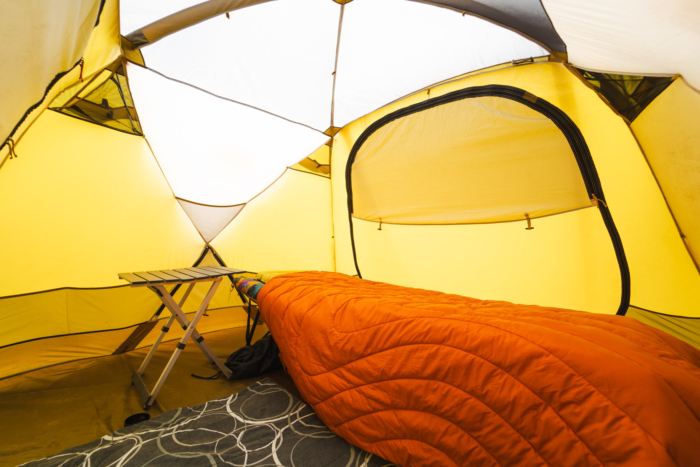
Rainfly
The next step in getting your camping tent up and rolling will be securing the rainfly. This topside cover stretches over the mesh canopy of your tent and provides weather protection, as well as trapping some warmth — a hot tip for hedging your bets against a chilly night.
Rainflies on many camping tents provide coverage for your average rainstorm, preventing top-down rain from ruining your night. The NEMO Aurora Highrise is a prime example of this, with a rainfly that extends out over the two side windows but doesn’t fully encapsulate them. At the far end of the spectrum is the Kelty Discovery Basecamp tent, which sports a rainfly that just covers the door of the tent. This makes for easier use and access but lower overall weatherproofing.
On the protective end of the equation, tents like the REI Co-op Base Camp borrow from the world of mountaineering-style tents and drop the rainfly all the way to the ground, ensuring that sneaky breezes or sideways rain have no way of entering. If you live in a place where surprise storms are common or want to camp further into the shoulder seasons, invest in a tent like this.
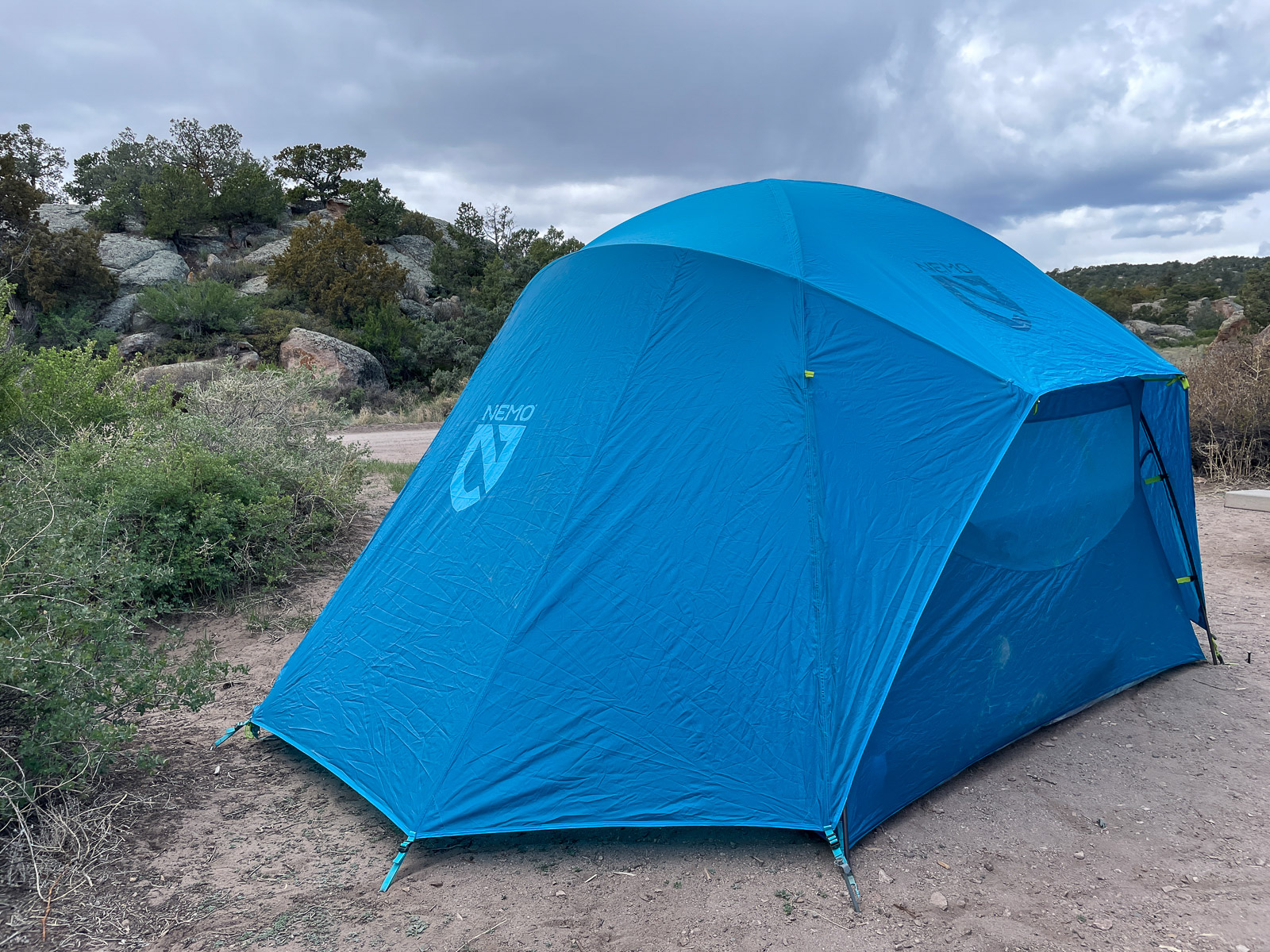
Doors and Vestibules
Of course, you’ll need a way to get into and out of your tent. We prefer two-door designs for camping tents simply because tumbling over your tentmate in the middle of the night is no fun. Tents like the REI Co-op Base Camp and NEMO Aurora Highrise boast full-size second doors, while more budget-minded tents like the Kelty Discovery Basecamp make do with one door.
A final mention here for specialty doors, such as those found on The North Face Wawona, where a half-size door at the rear of the tent adds a unique spot for loading gear or catching a cross breeze.
Vestibules are the garages of tents, and make excellent spots to stash kit that you want to keep close — coolers, chairs, shoes — but likely don’t want to share sleeping space with. Some tents sport an ample vestibule or two that will wrangle an average amount of kit, while others, like the REI Co-op Wonderland X, are built around the vestibule experience and become full-on second rooms.

Poles and Stakes
Here’s the backbone of your tent. Tent poles are most often segmented aluminum affairs that snap together and slide through pole sleeves or clip to the tent body to support it.
Pole structures can take several different forms. Dome-style tents like the REI Co-op Base Camp or Half Dome 2 Plus are classic and erect simply. They provide more weather protection in exchange for overall headroom.
Cabin-style tents like the Eureka Copper Canyon LX raise the roof and bump the walls out to be more vertical, but do struggle more in stiff winds. The REI Co-op Wonderland X is a final type of structure called a tunnel tent, which lands between the two styles.
Tent stakes are your anchors, and even if you don’t expect overnight wind, it’s wise to plant a few to keep your wilderness home from becoming mobile. Most tents will include basic stakes in a number that will keep your tent from flying away, but if you’re going to be using guylines (or expect high winds), it’s wise to invest in a few more stakes, or even stronger versions. A stake hammer can be a useful tool in getting your pegs in place, and we think that the MSR Stake Hammer is tough to beat.
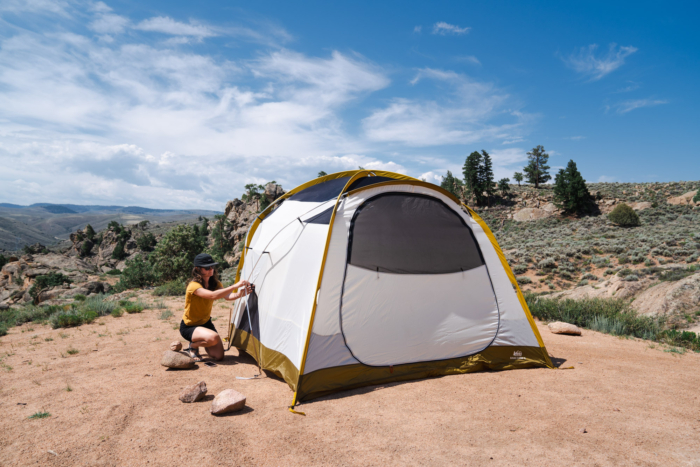
Storage and Organization
Keeping your camping kit organized can be important for maintaining your sanity, and built-in organizing solutions like pockets, sleeves, and gear lofts can help you organize your loose items. Some, like the NEMO Aurora Highrise 4P, place a handful of high pockets along the ceiling for stashing items such as headlamps or phones, while others, like the North Face Wawona 4, integrate large mesh panels that can store bulkier kit.
Your tent can benefit from some organization, as well. It will come packed away in a stuff sack that should carry all of the essentials to get you set up. Thankfully, many tent manufacturers have moved away from the true ‘stuff sack’ style storage bag and instead now offer zippered or wide-mouth-style bags that open wide to pack the tent inside. The wide bag that the Wawona packs into is easy to fill, but some aren’t as nice to use, and even our top pick, the REI Base Camp, had points deducted for its old-school stuff sack style bags.

Weather Resistance and Ventilation
If you plan to camp during storms, it’s worth it to save up and buy a sturdier tent. Premium tents have stronger poles, full rain covers, and sealed seams. It’s things like this that seem less important — until you find yourself riding out an epic storm from the confines of your tent.
While testing, we experienced a major thunderstorm complete with high winds and heavy rain. Each of the tents had been properly staked out, but many of them experienced damage. The Marmot Limestone 4P performed incredibly well, with no leaking or broken poles. The REI Co-op Base Camp 6 is also well equipped for inclement weather thanks to its rainfly and many tie-down points.
Ventilation is also key to camping livability, and windows are your best friend here. We place a high value on windows that can be opened from the interior of the tent, such as those on the NEMO Aurora Highrise. Some rainflys will also incorporate rigid stays, such as seen in the North Face Wawona, which holds open a ventilation port when the weather is good, and can be closed when storms brew.
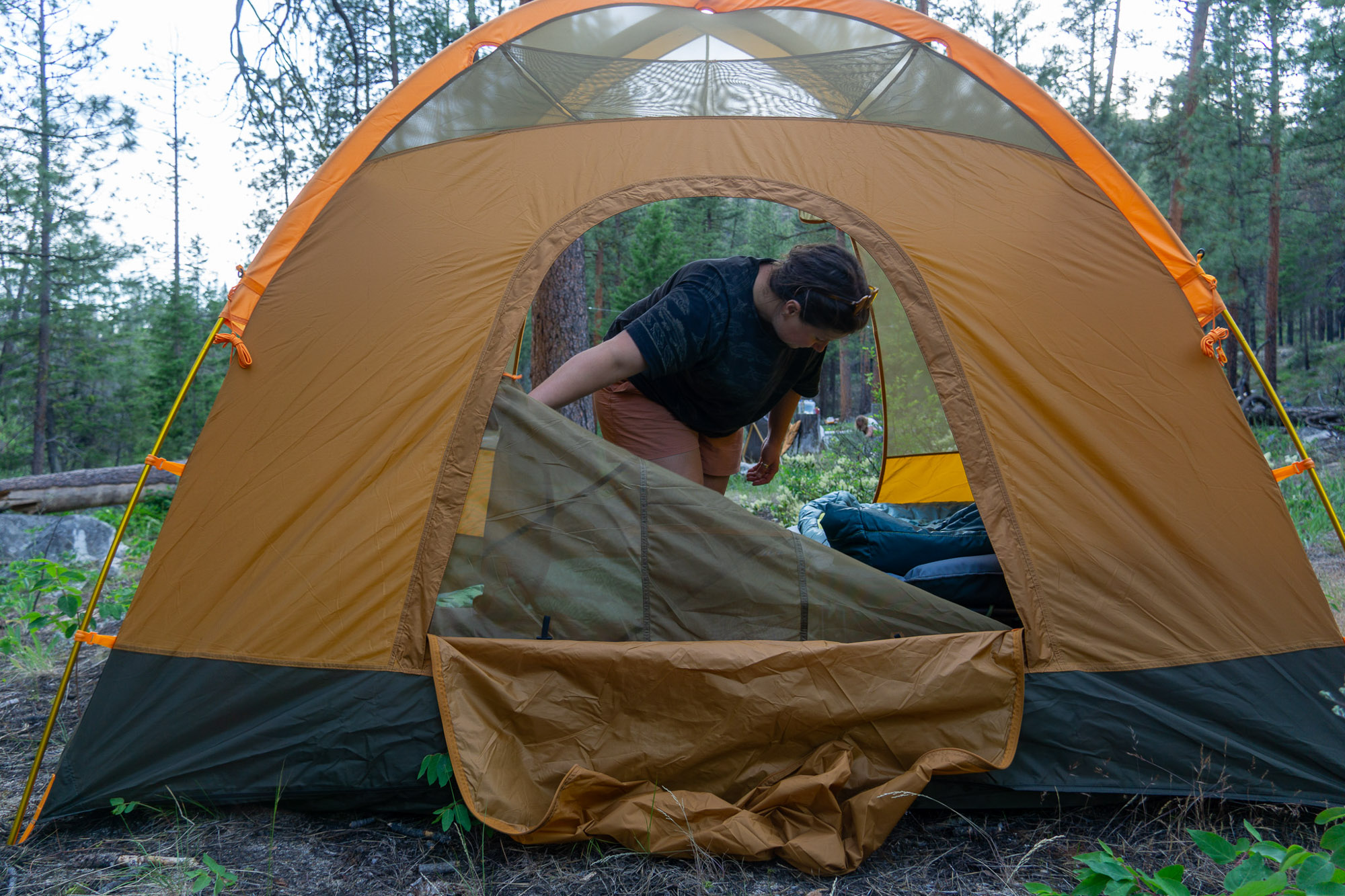
Seasonality Ratings
Often, manufacturers refer to its tents with a season rating, which helps convey the types of conditions for which they’ve been designed. While not a hard and fast rule, knowing where you are planning on camping, the weather you may encounter, and what your tent is rated for can greatly hedge your bets against spending a night in a flattened tent.
- 3-Season Tents: 3-season tents (meaning spring, summer, and fall) are your lightest-duty tents, and will employ lightweight materials in order to keep overall bulk down, as well as improve ventilation. Typically, the tent body will be nearly or entirely mesh and mated to a bathtub floor. These designs are less aerodynamic and more prone to bending under gusts of wind. Finally, most 3-season tents will use a rainfly that isn’t full coverage, and may only extend over windows and doors, instead of all the way to the ground.
- 3/4-Season Tents: Bulking up on weather resistance, 3/4 or 3.5-season tents are similar to 3-season tents material-wise, but in design, they often are more weather-ready, usually employing dome shapes. Rain flies will also go all the way to the ground, forming vestibules where you might store your backpacks during an overnight rain.
- 4-Season Tents: This is the realm of winter, mountaineering, and hunting tents, where weather resistance is in high demand and a tough structure is needed. Four-season tents are almost exclusively double-wall designs, and often shaped in domes or tunnels to better survive the wind. They will also sport many guylines to adequately support the tent, and thicker tent poles and materials to resist wind-driven rain and snow.
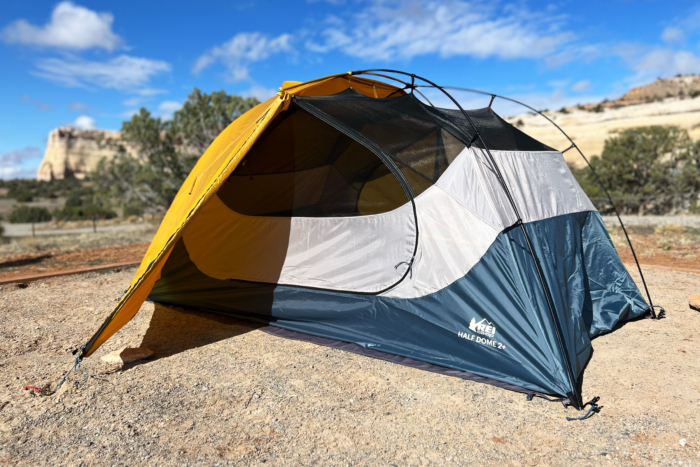
Capacity and Floor Area
Every tent worth its salt today will provide a capacity number for the number of campers it was designed to sleep. Many tent models are also available in multiple versions, with 4, 6, and 8-person capacities being the most common for camping tents. This number is derived from the number of regular sleeping mattresses that can be laid side-by-side in the sleeping area, but take note: this often only accommodates 20-inch sleeping pads.
The floor area number will also give you a good idea of the sleeping area space in any one tent, and is generally given in square feet. For 4-person tents, this typically comes in at around 60 sq. ft. For example, the Marmot Limestone 4-Person Tent slides in squarely at 60, while the more comfort-minded Mountain Hardwear Bridger 4 squeezes in a bit more at 62.5.
When it comes to 6-person models, the number jumps up to around 85 square feet, with the REI Co-op Base Camp 6 being the standard-bearer at 84 square feet, and the budget Kelty Discovery Element 6 surprisingly besting it at 89! It’s important to note here that the Kelty tent has less steep walls, and thus floor area isn’t the end-all when it comes to understanding overall livability.

Construction Materials
The weather resistance of a tent depends largely on the materials from which it is constructed. Nylon and polyester are very common materials used in car camping tents.
Nylon is stronger, more resistant to abrasion, and can stretch considerably. Unfortunately, it absorbs water, causing your tent to sag in storms or high humidity.
Polyester has less stretch than nylon, so it is more likely to tear. This rigidity is a benefit in wet conditions because it will sag less and absorb less water, but it also makes polyester more fragile.

Other Considerations and Taking Care of Your Tent
First and foremost, never put your tent away wet. Remember when we mentioned hydrolysis earlier regarding PU coatings? Water is a major culprit in speeding up that process. Fungi, molds, and mildews love to grow in your dark closet, on your wet tent, at room temperature. These organisms destroy the fibers of your tent and make it smell terrible.
When you get home, set your tent back up and let it air out. This simple chore will pay off later when you are still able to use your tent. If you have no yard or nowhere dry to set it up, your living room makes a great space for this. Check all the seams, especially the floor and fly, before packing it away.

Price & Value
A good camping tent can be one of the bigger purchases when putting together a good summer kit, so it’s important to know what you’re getting for those dollar signs. With a range from just north of a hundo to more than a grand, there’s a lot of territory to cover, and most of it will come down to three important metrics: the number of people the tent will sleep, the weather protection it provides, and the amount of accessories tucked away inside.
Budget
Camping is for everyone, and if you’ve only got a few frontcountry forays on the books for the summer, going to something with a little lower overhead can make a lot of sense. Budget camping tents are generally offered beginning at the $100 mark, and head up to around $200 from there.
A tent like the Kelty Discovery Basecamp 4 ($120) is a fine example. It’s not uncommon for tents in this realm to offer rain flies with less coverage over the body of the tent and often only incorporate a single door as an entrance into the tent. The REI Co-op Campwell 4 ($229) is another spend-wise tent we’d recommend to those looking to get further outdoors, but with an eye on the weather, as the tent shines best when the sun does.

Mid-Tier
Understanding the limitations of budget tents will safeguard against overextending them in harsh conditions, but for fair-weather campground camping, many do an admirable job. Beyond the $200 to about $500 mark, camping tents begin to feature hardier materials, full-coverage rainflies, and vestibules, with added niceties like internal storage options and windows.
You’ll also notice a price difference when looking at tents of different occupancies. For example, the REI Co-op Base Camp 4 is $475, while the 6-person version will run you $549. This nearly $100 difference between a 4-person and a 6-person tent isn’t uncommon, and many other manufacturers replicate this.
Premium
Beyond about $600 are high-end tents, which jam in the features to offer true frontcountry luxury. The Mountain Hardwear Bridger 6 ($950) exemplifies this with a burly mountaineering-inspired build, spacious and livable vestibule area, and an incredible amount of pockets and functionality. The asking price is a pretty penny, but the overall durability of tents like these means they’ll last a good bit longer than other, lesser tents.
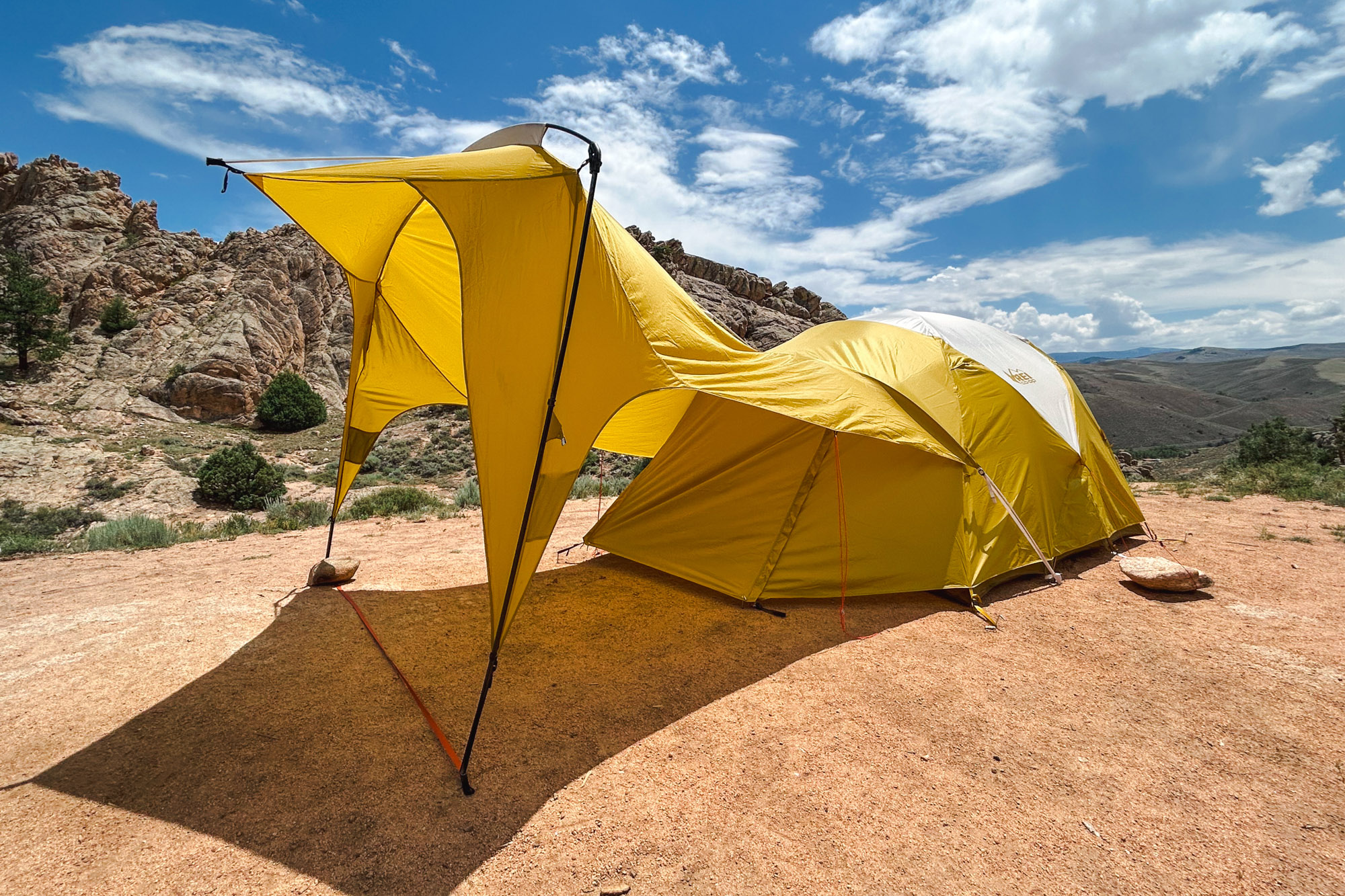
Frequently Asked Questions
The best family camping tent depends on your outdoor goals. In general, most families appreciate having more room and the ability to stand comfortably.
The MSR Habiscape 4 Tent has earned high marks from our family camping testers. If you regularly camp in adverse weather (hello, spring in Colorado), it’s worth considering a slightly smaller and more durable tent.
The best camping tent brand depends largely on your personal needs and budget.
For a premium tent that can withstand the weather, the REI Co-op consistently delivers. If you’re looking for maximum space and flexibility, the Eureka Copper Canyon is a favorite with families. And for a budget-friendly option that is built to last, check out Kelty.
If you plan to camp regularly, it is worth it to invest in a higher-quality tent. The extra expense means sturdier poles, waterproof seams, and generally an easier setup. If budget is a major concern, don’t let that stop you from getting outside.
We’ve consistently been impressed with the budget-friendly options from Kelty. The Kelty Discovery Basecamp 4 costs just $120 and offers plenty of room.
Quality tents are waterproof. But if you find yourself camping in an absolute downpour, hanging a tarp can provide extra protection and comfort.
It’s important to tie it up well so the wind isn’t a concern and to be sure that it isn’t touching the tent. In addition to creating an extra tent porch, a tarp is great for protecting your camp kitchen.

While there are many different styles of tents available today, each has a better use profile and ideal adventure to use them on. When it comes to camping tents, the most popular shape is a dome-style tent. This is because of ease of use, as well as the trade-off in canopy headroom to the overall complexity.
Some tents, like the REI Co-op Wonderland X, make use of a tunnel-style structure. These tents often boast more headroom overall, but will suffer some during high winds. For this reason, it’s important to properly guyline out a tunnel-style tent.
Other tents still, like the Eureka Copper Canyon 4 Tent or Decathlon Quechua 2 Second Tent, employ a collapsible style of integrated poles that forms a rigid structure once assembled. These tents are often among the easiest to use, but also the weakest overall, as any strong force against their poles could collapse them.

The Best Camping Mattresses of 2025
From packable sleeping pads to ultracomfortable air beds, we tested and found the best camping mattresses and sleeping pads to fit every adventure and budget.
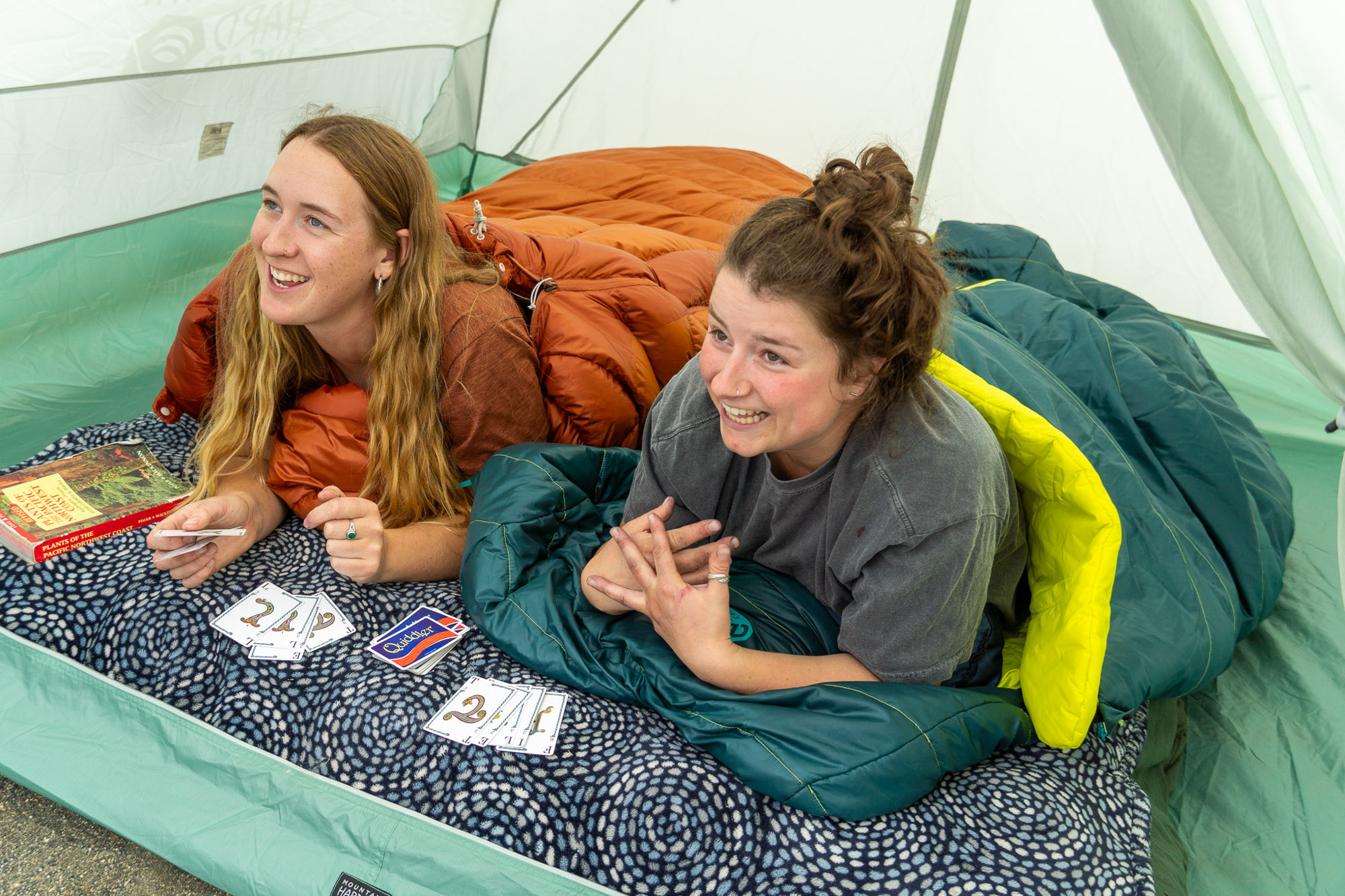
The Best Camping Sleeping Bags of 2025
From versatile camping bags to wallet-friendly picks, we’ve found the best sleeping bags for every use and budget.
